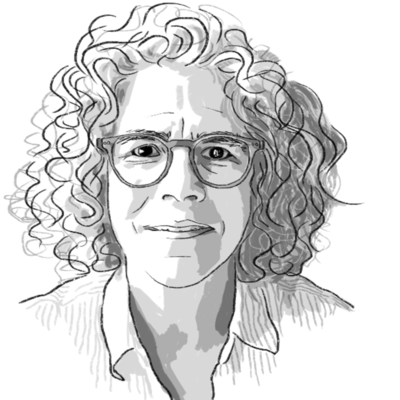- Quick Read
- Deep Read ( 18 Min. )

Why is Christian Science in our name?
Our name is about honesty. The Monitor is owned by The Christian Science Church, and we’ve always been transparent about that.
The Church publishes the Monitor because it sees good journalism as vital to progress in the world. Since 1908, we’ve aimed “to injure no man, but to bless all mankind,” as our founder, Mary Baker Eddy, put it.
Here, you’ll find award-winning journalism not driven by commercial influences – a news organization that takes seriously its mission to uplift the world by seeking solutions and finding reasons for credible hope.
Explore values journalism About usIn Today’s Issue
- What does it mean to be American? How 9/11 changed one Queens family.
- The long shadow of terror: How fear reshaped democratic values
- How 9/11 ‘clash of civilizations’ brought East and West closer
- One town’s beacon of 9/11 kindness: Gander shines on
- Coming of age after 9/11: Muslim millennials sense progress
- The 9/11 effect: By the numbers
Monitor Daily Podcast
- Follow us:
- Apple Podcasts
- Spotify
- RSS Feed
- Download
TODAY’S INTRO
How we choose to remember 9/11
Sept. 11’s defining moment for me came on 9/14 in a raspberry patch outside Boston – in a moment of collective relief among scattered strangers.
We all have that “where were you when” memory of events like 9/11, the Apollo moon landing, or JFK’s assassination. But the meaning of those memories can percolate over time.
Twenty years after 9/11, the word “anniversary” carries an oddly celebratory tone, admits Frank Ochberg, the psychiatrist at Michigan State University who helped define the term post-traumatic stress disorder. Yet, he adds, “we have a right to celebrate as we memorialize” – to celebrate “the values that we cherish.”
The event created what Dr. Ochberg calls “flashbulb” memories – moments around which we build spiritual, political, and moral meaning.
I hold two enduring flashbulb moments of 9/11.
On Sept. 13, I opened The Boston Globe to a photo of the familiar facade of the dumpy Park Inn motel in Newton, Massachusetts. Here, three hijackers apparently spent the days before their grisly mission. I passed the motel daily to drop my 3-year-old at preschool, the guest room windows close enough to see through. It was a chilling sense of proximity of terror.
And then, the flashbulb antidote: On Sept. 14, my daughter and I were among a dozen people in a suburban berry field, the raspberry stain growing on her T-shirt, when suddenly in the sky that had been silent for days, a commercial jet out of Logan International Airport roared overhead, close enough, it seemed, to see rivet dimples on the belly of the fuselage.
Its normalcy was a spectacular blue-sky moment – people exhaled sighs, shed tears. We were sharing a collective moment, small but vivid, in perceiving that life marked by historic tragedy could – would – find balance.
Share this article
Link copied.

Help fund Monitor journalism for $11/ month
Already a subscriber? Login

Monitor journalism changes lives because we open that too-small box that most people think they live in. We believe news can and should expand a sense of identity and possibility beyond narrow conventional expectations.
Our work isn't possible without your support.
What does it mean to be American? How 9/11 changed one Queens family.
The 9/11 attacks wounded the American sense of identity, security, and even reality. The meaning of that day to three generations of a lively Queens family is a window on the evolving understanding of what it is to be an American.
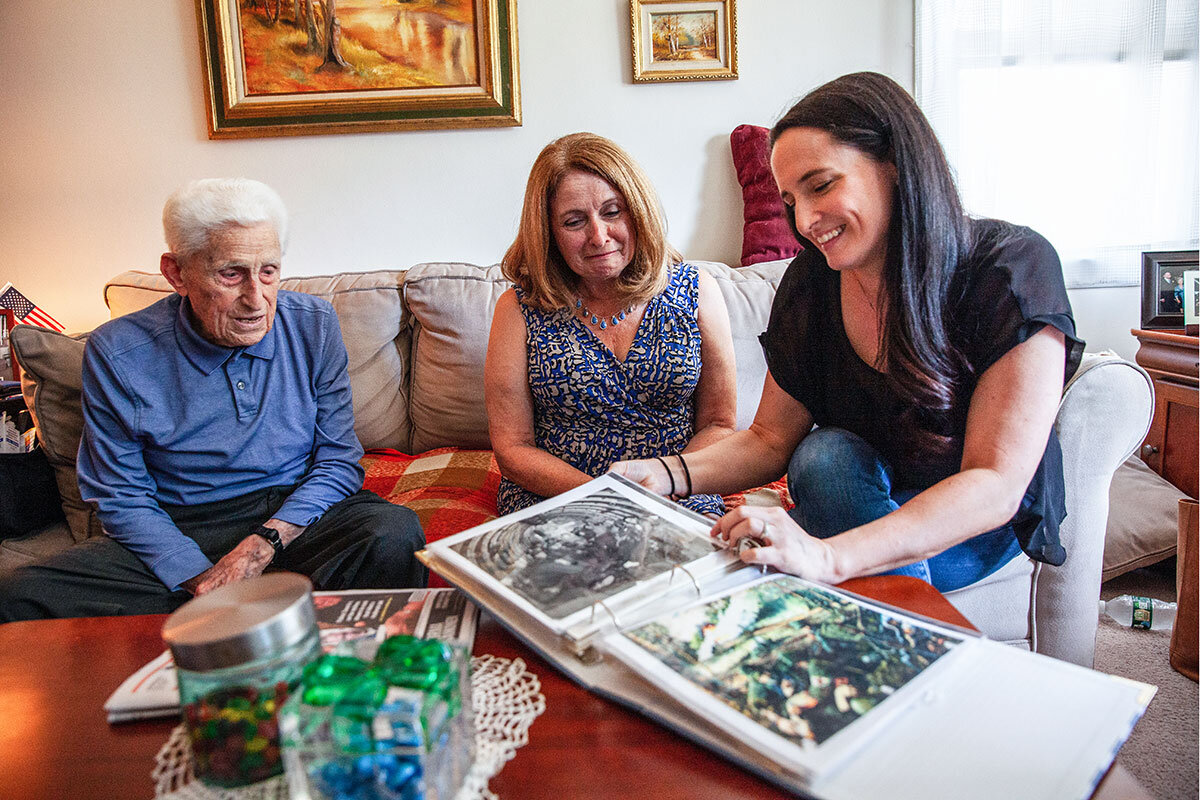
As James Lisa’s family goes, so goes the nation when it comes to how Americans have collectively processed 9/11 in the past 20 years.
For Mr. Lisa, a 102-year-old decorated World War II veteran, the attacks were a warning, and a reminder to heed the truths hard won by the Greatest Generation. For his daughter, Inez Regan, a nurse, 9/11 is still a painful, present shock to her baby-boomer understanding of American progress and exceptionalism. And his granddaughter, Katelyn O’Prey, sees in that crystal morning the launch of a millennial adulthood shaped by terror, a shift toward a worldview less trusting, but perhaps more open.
There are certain moments in history that ripple through a population, readjusting on a grand scale individual concepts of reality. Events like 9/11, say researchers, can shape one’s understanding of the world – of what it is to be an American. Across generations, an evolution takes place, even within a family: Mr. Lisa’s wariness, forged in war, evolves into a different type of questioning for Ms. O’Prey.
“9/11 was a catalyst for every generation – we have to pay attention to what’s going on in the world and understand what happened,” says Chicago Council on Global Affairs polling expert Dina Smeltz.
What does it mean to be American? How 9/11 changed one Queens family.
Twenty years later, Inez Regan still sees the dust.
“Awful, awful, awful,” she says.
It coated the faces of the firefighters, the laces of the boots she helped untie, the eyelids she tried to rinse clean.
“We were inhaling that,” she says.
She wonders about the long-term effects of that dust, the lingering asbestos and memories. What’s happened in her own life, these past two decades, that she can attribute to those shards of cement and country?
And at this point, does it matter?
She glances at her father, now 102, sitting next to her on the sofa in his small Fresh Meadows, Queens, duplex, her childhood bedroom upstairs. Her daughter, Katelyn, age 39, is walking across the room to retrieve her 3-year-old, Cole, who would like a bagel.
Life goes on. It really does.
Still, Inez thinks sometimes about how each member of her family absorbed Sept. 11, 2001, how that day tied them together but also exposed generational fault lines.
It wasn’t that anything particularly remarkable happened to them – at least no more so than to other New Yorkers, other Americans. They weren’t central characters in the devastation or the heroism; none went to fight in Afghanistan or Iraq; none were compelled to study Islam or international relations and begin a career in anti-terrorism or diplomacy.
Still, like one of those rapid-evolution experiments, where scientists watch as microorganisms exposed to stimuli change before their eyes, Inez’s family has changed. And while it’s impossible to say how much is explicitly connected to Sept. 11, they all agree that day has shifted – in different ways, at different times – how they understand and interact with their country, institutions, the world.
For Inez’s father, James Lisa, a decorated World War II veteran, the attacks were a warning, and a reminder to heed the truths hard won by the Greatest Generation.

For Inez, who is 70 and spent her career as a nurse, 9/11 is still a painful, present shock to her baby-boomer understanding of American progress and exceptionalism.
Katelyn O’Prey, Inez’s daughter, sees in that crystal morning the launch of a millennial adulthood shaped by terror, a shift toward a worldview that is less trusting, but also, perhaps, more open.
Their lives, over the past 20 years, have been both remarkable and mundane: Sunday family dinners and special occasions at Anthony’s Italian restaurant, posing for pictures that will go on the family photo gallery on the stairwell, weddings and divorces and deaths and births, moments of bravery and the everyday of laundry and groceries and commutes and car seats.
Through it all, Inez’s family has reflected something both singular and universal. It shows a changing, evolving America, still shaped by 9/11.
Processing what it is to be “us”
There are certain moments in history, in a country, that ripple through a population, readjusting on a grand scale individual concepts of reality. Researchers sometimes call these events collective traumas, times when the framework of society seems to shatter, and what has been suddenly erupts into what is. In the United States, 9/11 was one such moment – a trauma both personal and communal. Psychologists and anthropologists study how groups form meaning and memories around these events, how they piece together disparate shards of understanding. Eventually, they say, societies build new scaffolding, a new normal, a freshly edited narrative of past, present, and future. This is how we find stability, they say, how we understand what it is to be us.
But we do not go through this process uniformly. Researchers who study collective trauma, such as Dana Rose Garfin, an assistant professor at the University of California, Irvine, say people in different life stages have different ways of metabolizing events. Children process trauma differently than adults. Teens are affected in unique ways. Stress can be cumulative, and concurrent negative life events, traumatic incident after incident, can amplify one’s response.
Media exposure also matters. Watch an airplane fly into a skyscraper, again and again and again, and the distress compounds.
“There can be measurable impacts on the population for quite some time,” says Dr. Garfin, who has explored the ways young people reacted to the 9/11 terrorist attacks. And while she cautions against generalizing generations – a millennial born in 1980 might have more in common with a Gen Xer born in 1978 than with someone raised 15 years later – she does see distinctions in the way age cohorts processed the event.
She and other scholars, for instance, have theorized that the attacks had a long-term impact on millennials’ political attitudes. According to longitudinal surveys, that generation is less trustful of institutions, less likely to say America is the best country in the world, and, according to data from the Chicago Council on Global Affairs, less likely to support U.S. military intervention internationally. They are also more comfortable with immigration, and more likely to believe that countries should cooperate to address the world’s biggest problems.

But it’s hard to know for sure whether those attitudes are a direct result of 9/11, cautions Chicago Council polling experts Dina Smeltz and Craig Kafura. One’s age at the time of polling, rather than generation, might be the stronger influence. When boomers were younger, they, too, were less likely to say that the U.S. should take an active role in world affairs – 59% compared with today’s 72%. For them, the Vietnam War was a collective crisis. Living through the Cold War, Ms. Smeltz says, also seems to be as much an indicator for geopolitical attitudes as anything else.
Which, in some ways, is exactly the point.
Across generations, there are events that shape one’s construction of the world, sense of safety, and understanding of what it is to be an American. But an evolution takes place, even within a family. The wariness of James Lisa, forged in war, evolves into a different type of questioning for Katelyn O’Prey. And there comes a point, whether 20 years later or 80, when current events fade into gauzy historical memories, faded newspaper clippings tucked into an album like the one people browsed through at James’ 100th birthday party.
Then a new generation moves forward, claiming a new version of hope for what the world can be.
“I guess I’m going to war”
Time moves in strange ways, James knows. That’s one of life’s truths.
Forget about 20 years. Four times that many can go by, and it still takes you by surprise that you are no longer headed off to war, a young man on a battleship taking an unexpected turn through the Panama Canal. Instead you’re sitting here, in the house you bought with a GI loan, next to your daughter and granddaughter and your great-grandson, who is showing you a plastic dinosaur that roars.
Another truth is this: There will always be moments that expose vulnerability, the dangers in the world, the need to be prepared to fight for good.
But it seems the younger folks need to keep learning that one for themselves.
For James, Sept. 11, 2001, was shocking but not unimaginable. The past century has repeatedly proved that hardship and threats lurk just beyond our daily mirage of invincibility.
It was the Depression that first taught him worry. His friends’ parents lost jobs; his own struggled. He might not have been starving, but he still knew to treasure food. He saw the hidden, easy permeability in that line between getting by and not, between safety and destitution. He had wanted to be a journalist, and he could type, but he knew he needed to take whatever job he could get. So he began working for a military supply depot in Brooklyn. And then came Pearl Harbor.
Like many of his generation, James doesn’t easily talk about feelings. It seems a strange question to ask how he felt about the 1941 Japanese attack on the American Navy base, or about the 2,400 killed that day. As if his inner life has anything to do with the matter.
“What did I think?” he asks. “I thought, ‘Guess I’m going to war.’”
He went into the Army because that’s where they told him to go, he says. He’d asked the major at the supply depot to recommend him for the Signal Corps. Instead he was assigned to the 31st Infantry Division. He went to Camp Shelby in Mississippi, then to West Virginia for mountain training, which he believed was preparing him to fight in Europe. Later, when his ship turned into the Panama Canal, James realized he was going to the Pacific.
In the Army, they don’t tell you much.
He recorded everywhere he traveled on a dollar bill: Panama Canal. Milne Bay, New Guinea. Pacific Ocean. Coral Sea. Morotai. He still has the dollar. It’s in an album, near a clipping from the Long Island Star-Journal, a paper that stopped publishing in 1968, showing James in a photo under a headline declaring that enemy shrapnel was no match for this Corona, Queens, fighter.
It still isn’t. The metal has been lodged in James’ back since that day in New Guinea, when he went to repair communications lines and his crew came under fire. They dug foxholes and heard the mortars explode, and then he felt the hit. Wounded, he waited until dark, and crawled back with his men to the beach and their commanders.
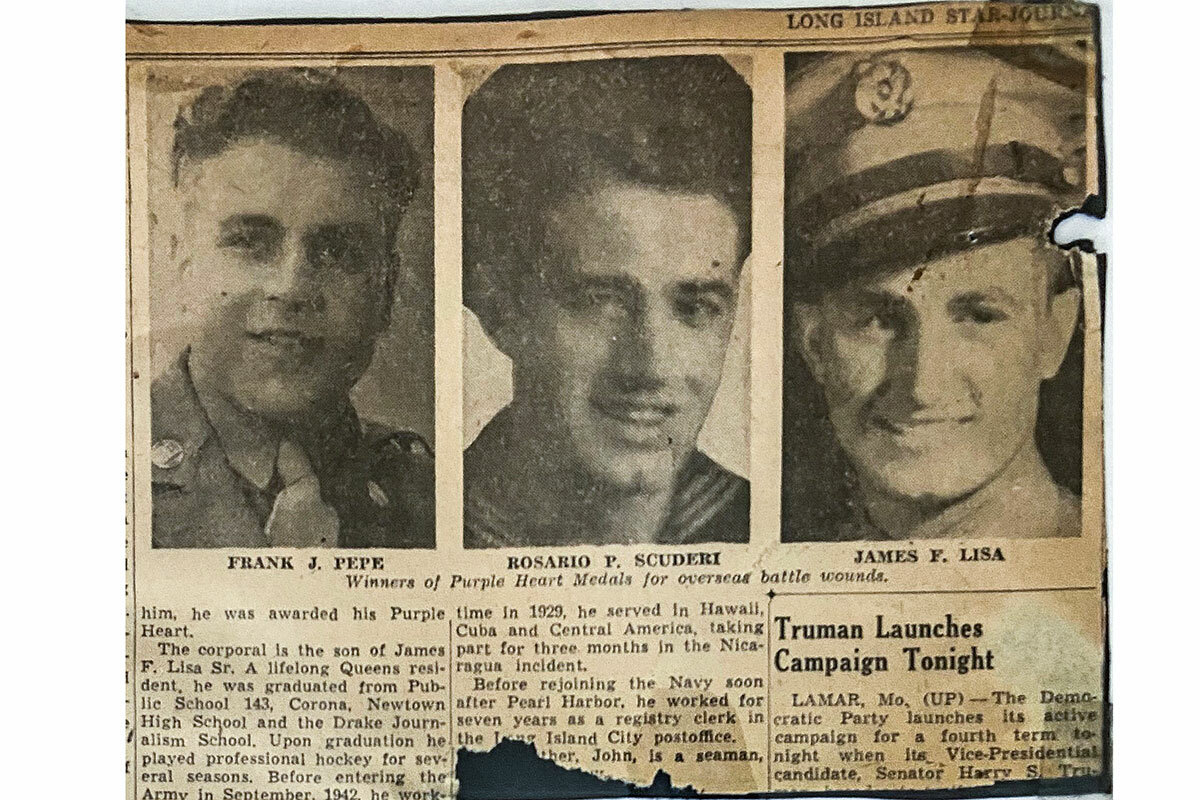
James stayed in the Philippines after the end of the war, until a boat arrived to bring the troops back to San Francisco. Because he was a “high pointer” with marks for bravery or injury, he got to fly east from there. A photo of that is in his album, too – men squeezed on troop-carrier benches, staring at the ground or the rucksacks at their feet.
“First class,” he says.
His father hugged him when he opened the door of his childhood home: “Hugged me, can you imagine?” he muses. His mother cried – he’d expected that. But his father? His father owned a bowling alley and pool hall in Corona, which at that time was filled with other Italians. The elder James Lisa didn’t look imposing, but he was hard-nosed enough to handle the toughs who might try – only once, mind you – to mess with him.
But James’ father had a soft spot. He doted on his wife, the only member of the family actually born in Italy, who’d moved from the old country to an apartment under the L train and almost had a nervous breakdown because of the noise. Later, after James met Amelia, and they’d married and moved to Fresh Meadows and had their little girl, his father let the toddler walk on his pool tables: Little Inez can do whatever she wants, said her grandfather, glowering at anyone who might suggest otherwise.
James took a job as a letter carrier after the war, and worked his way up to customer service director for Queens’ postal complex.
“I learned how to handle people,” he says. “Sometimes you can smile and sometimes you can growl and sometimes you can agree with them even though you don’t.”
It was a skill he used for his family as well. He didn’t talk about the war much. “You lose a lot of it, thank God,” he says.
And then, what was there to say? “You talk about the lessons you’ve learned and you see the eyes glaze over. After a while, I figured, they’re living their own lives,” he says. “To me [the war] was a big thing. For them – it was what I did.”
For decades, he kept his memorabilia in boxes upstairs – tropics-faded, wallet-sized photos he’d carried through the Philippines; news clippings; documents from the Army. He kept a photo of the YMCA hockey team he played with before the war, the Corona Rangers. It’s in the album now, and beneath it he has made a list, under the words “Cost of Freedom”: Nils Odstrom, killed in action. Clyde Brightman, a prisoner of war. Benjamin Siminetti, killed in action, D-Day. Few members of the team survived.
James has always believed America is the best country in the world, a nation willing to sacrifice for freedom. But he wonders if people forget what sacrifice really means. They surely forget how important it is to be ready, to have sound defenses.
Sept. 11, 2001, confirmed that.
He’d retired from the post office and was working as a tax accountant when the attacks happened. He returned home and turned on the TV, taking the same position that he had when President Kennedy was shot, when Apollo reached the moon.
James’ world changed over the ensuing 20 years. He lost a wife, a daughter, and a brother. Other World War II veterans in his neighborhood moved away or died, and no more children play on the streets, watched over by neighbors through windows, ready to break up any nonsense.
But something else has happened, too. Young people have become far more interested in his experiences. His grandchildren began asking him about the war, and he started sharing – first with the boys, then with the girls. He kept to funny stories for a while, but eventually let the more serious slip in. His granddaughter Katelyn and her brother drove him to visit the World War II Memorial in Washington, D.C. Grandnieces and nephews crowd into his hotel room at family weddings, asking for his tales.
Someone gave him a veteran’s ball cap. Strangers are kind to him when he wears it. He still drives – a new Kia – and the other day when he pulled up to the local elementary school to vote, police officers saw the cap, thanked him for his service, called him “Sir,” and told him to park wherever he’d like.
He doesn’t know what he’ll do for the 20th anniversary of Sept. 11, if anything at all. Maybe he’ll see his daughter, who was one of the helpers in lower Manhattan.
That day, he knows, is hard for her.
Nobody came from the wreckage
The boy came into the nurse’s office that day complaining of a stomachache. This child was one of her “regulars,” Inez says with the warm laugh that shows why middle schoolers at Intermediate School 10 might have regularly found ways to trade class for her company. “I am a bit of a nurturer,” she says, almost guiltily.
But this time, the boy seemed particularly out of sorts. He said he’d looked out the window and watched a plane fly into the World Trade Center. It went right into the tower, he insisted. Inez remembers exchanging glances with her colleagues. As a nurse with the city’s department of public health, she heard a lot. But this seemed stranger than normal. She told the child he could rest in the infirmary.
But of course, he was absolutely right. He would have had a straight view of the attack from the school’s upper floors, nearly as clear as the image from the No. 7 train that Inez rode the next day from Queens to Manhattan.
There hadn’t been a question of whether she would go. She’d stayed at school after the attacks, waiting as frantic parents arrived to grasp their children, all the rules of pickup and drop-off shattered into inconsequentiality. Her own children were young adults, her sons working and Katelyn in college. She’d made contact with each and knew they were safe. So she had to help. She called her parents to let them know she would be going to ground zero the next morning. Her mother was unhappy; her father understood.
The crowd in the train car was hushed, passengers gaping at the place where the towers had stood. The first glimpse of the broken skyline was “mind-blowing,” she remembers.
The trains only went so far, so she walked the rest of the way to Chelsea Piers, the new sports and entertainment complex on the Hudson River where officials had set up a medical triage center. The crowd grew larger as she made her way south – doctors and nurses and volunteers appearing from their own corners of the city, joining together to move as a group toward the wreckage, hoping to do something, anything, to help.
When she got to Chelsea Piers, she walked by table after table set up across what had been soundstages, past state-of-the-art medical equipment and pods of doctors and nurses ready to treat a wave of acutely injured people pulled from the rubble.
But no victims arrived. The morning crept into the afternoon. Once Inez rode an ambulance with a doctor because rescue workers thought they’d found someone in the rubble. But it was a false alarm. Soon it began to dawn on the volunteers that nobody would be coming from the wreckage of the towers. Indeed, fewer than 20 people survived the towers’ collapse, according to most sources, and most of those individuals were recovered by Sept. 12.
The nurses at the triage center eventually began helping the rescue workers, firefighters, and medics. Inez made sure they had water, helped them tie their shoes, cleaned off the dust, washed out their eyes.
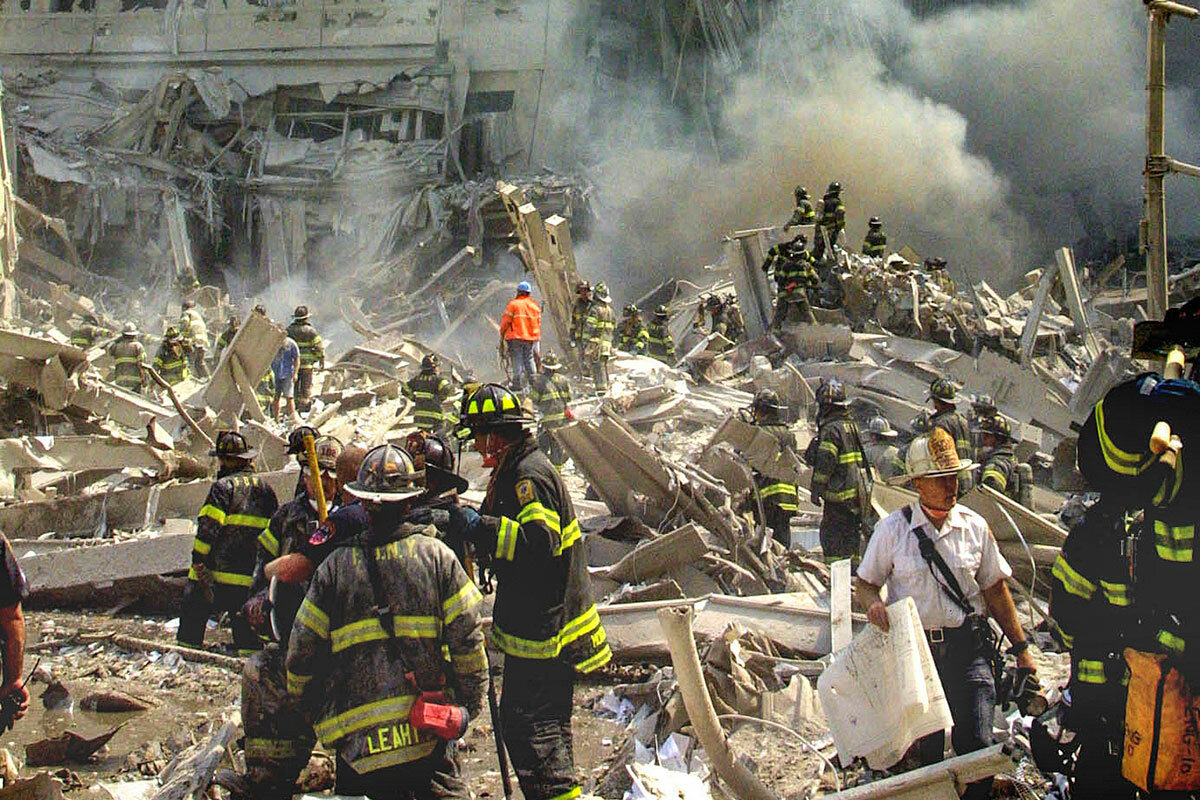
For the next 15 years, she couldn’t bring herself to return to downtown Manhattan.
It’s not that Inez can’t imagine violence or conflict. She’d grown up acutely aware of her father’s role in World War II, even if he rarely talked about it. Her childhood was infused with a deep respect for what it means for people to fight for their country.
She didn’t actively oppose the Vietnam War, because she felt that was just too disrespectful of the boys fighting. She bit her tongue when her peers railed against the military, the government: “I didn’t support the war. I supported the soldiers.”
But Sept. 11 was different. It felt personal. It was her city attacked, her country, a nation she still believes – despite all the political divisions and struggles and mistakes – is the best in the world.
“We have our freedoms here,” she says. And then she glances at her father and adds, “Only because of what he did in the war.”
Every year, at the beginning of September, Inez wonders whether she’ll have the strength to watch the anniversary TV scroll of names of 9/11 victims. She regularly tells herself that this year she won’t do it, that she’ll let the day fade into the past.
She always watches, though. Every year.
Questioning “great nation” status
Her daughter doesn’t watch.
For a few years, Katelyn took a moment, like many of her friends, to watch the names, honor the first responders, and remember the attacks that had christened her adulthood. But then the ceremonies faded out of her life. Only the unease remained.
She was in college on 9/11, and probably would have seen the first plane hit One World Trade Center if she hadn’t been looking down, earphones connecting her focus to her music. The broad, familiar skyline of Manhattan was clearly visible from the overpasses on her bus route to Queensborough Community College – a constant backdrop to her life, weighted by the twin towers to the south, the Empire State Building in the middle, flat Central Park uptown.
Everyone was acting “really weird” when she arrived on campus. This was before smartphones, so there were just whispers and rumors as classmates shifted around a lecture hall. Eventually the professor arrived and said there’d been an explosion: Classes are canceled. Call your families.
She made her way to the theater department, where she was a major, and huddled in the greenroom with her classmates: “Everyone’s freaking out and, you know, you’re not even sure why you’re freaking out.”
The students were loaning phones, offering their minutes to distraught classmates, but calls wouldn’t go through.
Katelyn ended up at her parents’ house that day instead of the apartment she shared with friends, although she doesn’t remember how she got there. She stayed there until her shift a few days later at a restaurant and sports bar in a neighborhood of Queens that, like many in that area, was in mourning. World Trade Center commuters had lived there; the fire departments were some of the first to respond to the attacks.
At some point that evening, police cars began driving slowly outside the restaurant; then firetrucks and ambulances joined them, and then the people, stopping their constant New York movement to stand still on the sidewalk and wave the American flags that somehow everyone had acquired in those days after the attacks. The crowd started to sing “America the Beautiful.”
A feeling went through Katelyn, a sense she’d seen something remarkable – a city that was nicer, where people supported each other regardless of what they looked like or where they lived or how much money they had. She kept noticing it over the next few weeks. Strangers stopping to hug each other. People asking if others were OK.
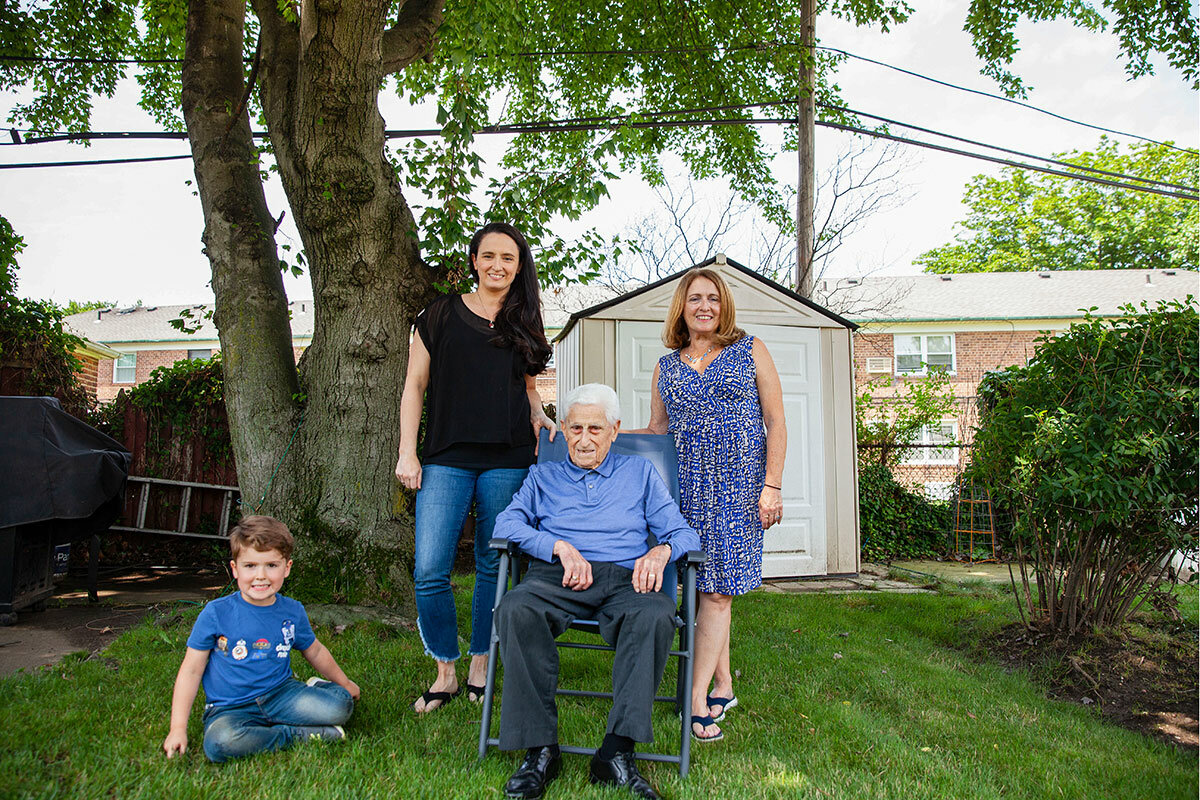
But as time went on, other feelings took over. As the U.S. went to war in Afghanistan, she worried whether there’d be a draft, and if her brothers would be called to fight. The mail turned dangerous, with anthrax-laced letters sent through the post. Her grandfather no longer worked for the Postal Service, but still ... The car-choked tunnels into Manhattan, she heard, could be a new target for terrorists. The subway, too. Suspicious activity should be reported, she knew, but ... on the New York City Subway? Every fifth person seemed strange in the best of times. The quirkiness of the city took on a darker tone.
Near her 21st birthday, Katelyn and Inez were at Elizabeth Arden in Manhattan – a mother-daughter spa day – when the lights went out across the city. They fled the building in pedicure flip-flops and joined the throngs walking over the East River bridges, away from the island, wondering what terrible thing had happened this time.
Even after she learned that it was a massive blackout, not terrorism, the sense lingered that at any moment, something bad could happen. That anxiety was always under the surface, erupting as when a steam pipe exploded in midtown in 2007. Working at a restaurant nearby, she and her colleagues heard the rumble and saw the geyser and bolted out the back door, running frantically away, anywhere away: “We were basically running for our lives.”
It wasn’t only Sept. 11 that gnawed at her sense of safety. She and her friends were in high school when two seniors shot their classmates at Columbine High School. As she got older, those school attacks continued. In her daily life, she read the warnings on public transportation; she saw the metal detectors and security go up in buildings, stadiums, airports. She realized she, and many of her friends, were moving toward a way of being that her husband, Mark, described from his childhood in Northern Ireland – a foundation of mistrust, of knowing you have to protect yourself because threats can be anywhere.
But those threats, for her, didn’t come from “outsiders.”
She knows many people – mostly older, she believes – blamed Muslims and Islam in the wake of the attacks, but that never made sense to her. She didn’t travel much as a child, but maybe because of the many ethnicities she encountered in Queens, or the shrinking of the world through the internet, or just a different sensibility among her peers, she’s always felt comfortable with people of different backgrounds.
Despite her grandfather’s dollar bill of destinations, she knows millennials have traveled more widely and differently in the world than older generations; her cohort has tried to integrate and experience, not conquer. She’s no jet-setter herself, although she’s married to someone from abroad, and knows in a way – so deep it’s like breathing – that other cultures exist, thrive, and evolve.
That’s partly why she can’t agree that the U.S. is the best country in the world. What’s best? What does that even mean? She’s proud to be an American; she considers herself patriotic. But who is she to judge superiority?

Pew Research Center
Katelyn doesn’t plan to attend any ceremony for the 20th anniversary of the Sept. 11 attacks. She might think about it, of course, when she looks at the Manhattan skyline from the Kosciuszko Bridge as she drives between her home in Maspeth, Queens, and Greenpoint, Brooklyn. It’s so different now. You can barely pick out her favorite, the art deco Chrysler Building, because it’s so dwarfed by new towers. She doesn’t like it. The balance is off, leaning toward the skinny matchbox skyscrapers reaching up from midtown, each vying for the record of tallest.
She and Mark own a construction company. During the week, their team installs drywall and framing to build that new landscape of New York. On weekends, they sometimes take Cole to a local Irish restaurant. The child asks about the plaque there, with the two tall skyscrapers and the many, many names. Katelyn thinks about that day, the deaths, and wonders how to explain it to her 3-year-old. She remembers the people hugging on the streets, the glimmer of hope for a nicer, kinder world.
Those are buildings that aren’t there anymore, Katelyn tells her son. The plaque is so we remember them.

The long shadow of terror: How fear reshaped democratic values
How much freedom must we give up for national security? It’s an enduring post-9/11 ethical challenge for the West – but harsh measures that violate human rights are often checked by moral correctives.
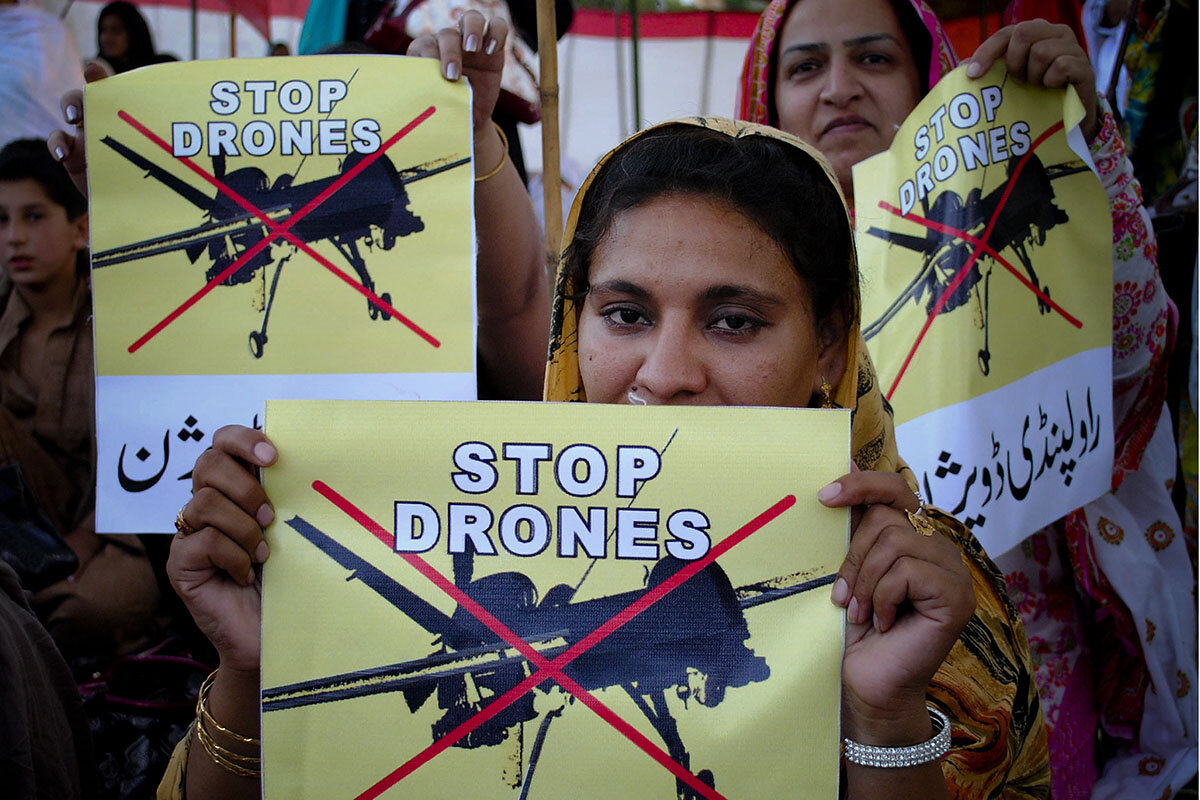
- Quick Read
- Deep Read ( 9 Min. )
It’s not only the American way of life that has changed since the 9/11 attacks 20 years ago. So has the American way of war.
The U.S.-led “war on terror” transformed warfare, mobilizing harsh counterterrorism tactics that shook democratic values at home and abroad. It also sparked a corrective moral backlash. And the struggle between the two is a key legacy of 9/11.
The fact that America hasn’t suffered a major jihadi attack on its soil for two decades leads some to argue that the counterterror effort succeeded. But others say the U.S. lost the moral high ground in wielding such tools of anti-terror as intrusive mass surveillance, torture, extraordinary rendition, drone killings, immigration bans, and law enforcement sweeps and detentions of terror suspects without charges.
“The United States certainly tarnished its reputation as a beacon of values,” says former CIA officer Douglas London, author of the upcoming memoir “The Recruiter.” “It’s a country that has made some serious mistakes for which it should be accountable. But I think the fact that we have had that conversation in the United States is a reflection of what we are fundamentally. We don’t want to be the bad guy.”
The long shadow of terror: How fear reshaped democratic values
John Kiriakou remembers 9/11 like it was yesterday. It made no sense to the CIA counterterrorism officer that a plane would accidentally crash into the World Trade Center on such a sunny day. When the second plane hit, it was clear to everyone at the CIA that the U.S. was under attack.
There were roughly 600 people working at the CIA Counterterrorism Center that day. On 9/12 there were around 1,600, he says.
Shock quickly gave way to revenge.
“There were 3,000 Americans who died because we didn’t do our jobs,” Mr. Kiriakou says, recalling his stateside boss sending him off a few months later to chase Al Qaeda militants as CIA counterterrorism operations chief in Pakistan. “He said to me, ‘Kill them all.’”
Mr. Kiriakou – who went on to be the first whistleblower to confirm that waterboarding, a form of torture, was official U.S. policy – summed up the era in a Monitor interview this way: “9/11 was the watershed that permanently changed the American way of life. We’ll never, ever go back to our Sept. 10 country.”
It’s not only the American way of life that has changed. So has the American way of war. The U.S.-led “war on terror” transformed warfare, mobilizing harsh counter-terrorism tactics that shook democratic values at home and abroad. It also sparked a corrective moral backlash. The struggle between the two is a key legacy of the 9/11 attacks 20 years ago.
“How do you balance the rule of law with the security principles put forth by politicians and demanded by the public?” wonders Nacer Lalam, a member of the European Experts Network on Terrorism Issues. “There is a permanent tension. How far we can go in sacrificing our individual liberties in the name of security has been a question across Western countries.”
The catalog of controversial anti-terror tactics used at home and abroad includes intrusive mass surveillance, torture, extraordinary rendition, drone killings, immigration bans, law enforcement sweeps and detentions that turned residents – especially Muslims – into the enemy, and detention of terror suspects without charges.
The fact that America hasn’t suffered a major jihadi attack on its soil for two decades and that the U.S. killed Osama bin Laden, founder of the Islamist terrorism network that committed the 9/11 attacks, leads some to argue that the war on terror succeeded. Others suggest the U.S. lost the moral high ground, triggering a shift of values and legal norms globally.
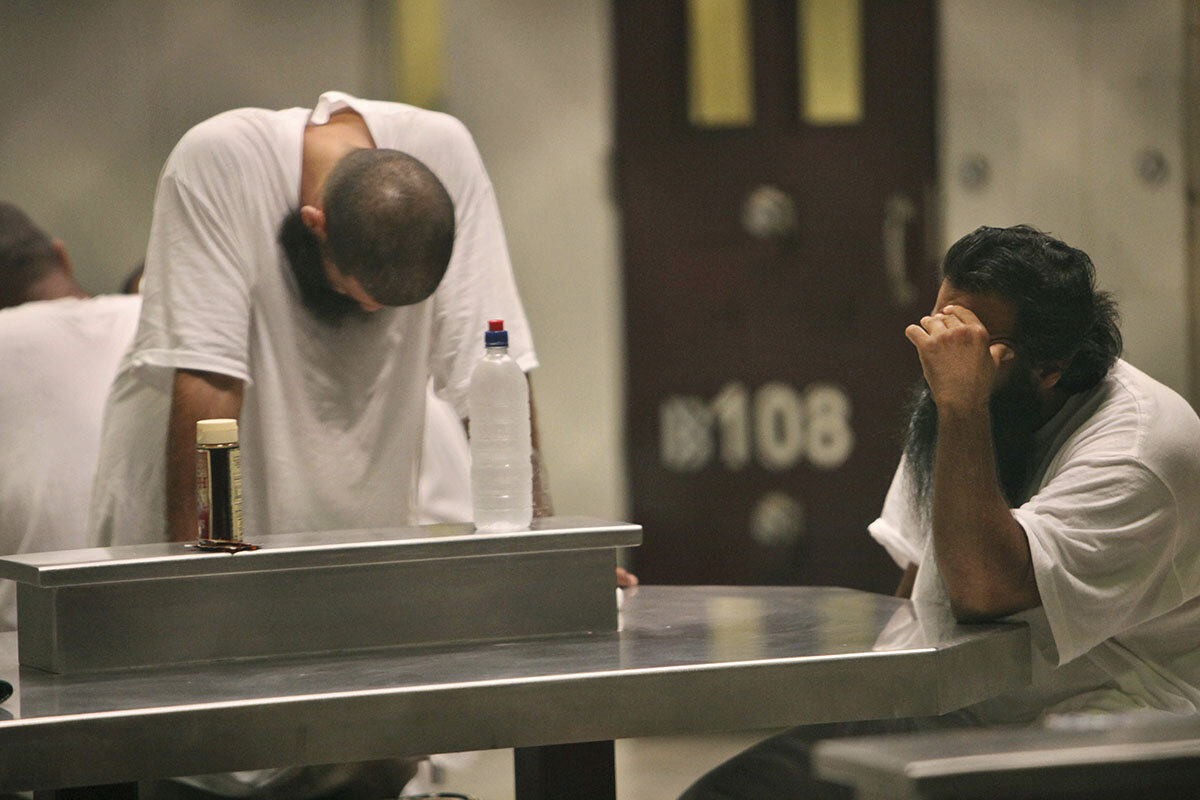
Today, though the old competition between great powers is again the big focus of security, countering terrorism remains a global imperative powered by cutting-edge technologies that encroach on freedom of expression, religion, and privacy, say those who’ve sometimes successfully fought to check the spread of these practices.
“9/11 changed American public opinion and, to me, that’s far more dangerous than changing policy,” says Mr. Kiriakou, now a radio host on Russia-sponsored Sputnik.
Indeed, public fear has fueled strong majority support for counterterrorism as a top priority in Pew Research Center polls since 9/11. But the swing toward security compromised U.S. values and the Constitution and “set a dangerous precedent for other nations,” says Hina Shamsi, director of the national security program at the American Civil Liberties Union.
“In the name of national security and counterterrorism, the U.S. government violated human rights, damaged the rule of law, international cooperation, and the United States’ reputation,” she says.
Domestically, the 9/11 attacks paved the way for security measures that hit communities of color the hardest. The FBI enjoys expanded powers to carry out intrusive investigations without evidence of wrongdoing. Even after the revelations of mass surveillance of phone records by National Security Agency contractor Edward Snowden, U.S. surveillance capabilities and secretive legislation around them remain so complex that few grasp their full effect. Over a million people are on the government’s watchlist of known and potential terrorist suspects, which has been challenged in court by U.S. Muslim rights groups.
“When you are subjected, as so many Muslims and immigrants were, to special registration ... or the Muslim [immigration] ban,” says Ms. Shamsi, “U.S. values are betrayed again and again.”
Internationally, the U.S. war on terror put American troops in Afghanistan and helped justify the 2003 invasion of Iraq. Some of the darkest chapters of that war – such as the abuse of detainees in Abu Ghraib prison in Iraq – came in the early years. Europe initially held the line on human rights, then mimicked the U.S. when terror attacks hit its turf.
The Al Qaeda attack on the World Trade Center and the Pentagon succeeded in striking terror in American hearts. The national security panic following the attack created perhaps the most ethically challenging moment the nation has faced as it embarked on the dark pursuit of unconventional, asymmetric warfare with a nonstate enemy.
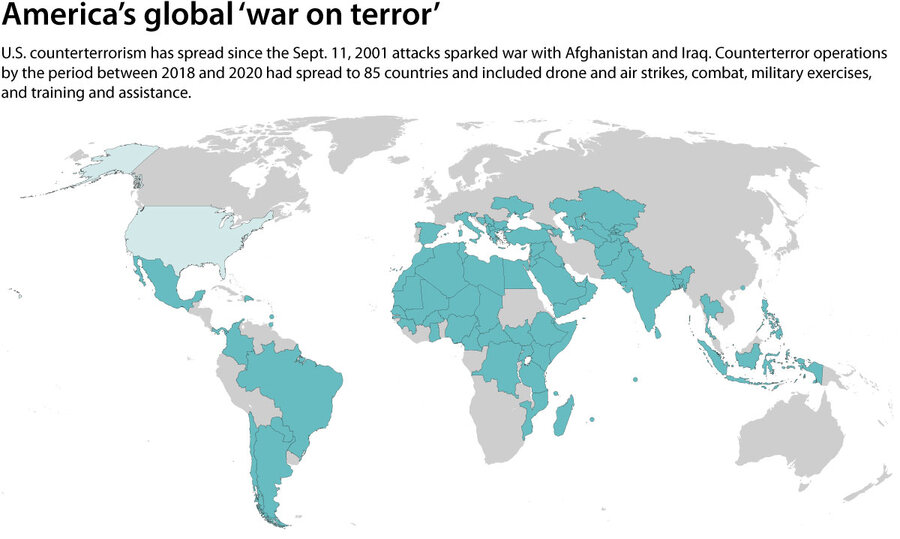
Brown University’s Watson Institute of International and Public Affairs
“We as a country felt justified, that we were wronged, and that we have a right to strike back,” says former CIA officer Douglas London, author of the upcoming memoir “The Recruiter.”
“There was just such a state of panic that we were going to be hit again, that rules became a lot looser and gray,” he says. “The same principles applied, but a lot of it was about developing capabilities as quickly as possible” to buy time to thwart other attacks.
Many extraordinary practices have been dialed back or discontinued since 9/11. Others have become normalized, anchored in institutional processes, or codified into law.
Counterterrorism in her own backyard
Pressure to uphold American values and international law in counterterrorism efforts has come from many fronts, including ordinary citizens unversed in the ways of war.
When Christina Cowger learned that the CIA front company Aero Contractors used North Carolina airfields in its extraordinary rendition flights, she was furious they were happening in her own backyard with taxpayer dollars. From 2001 to 2005, extraordinary rendition involved nabbing suspected terrorists off the streets in other countries and bringing them extrajudicially to the custody of the U.S. or other countries for interrogation and, in many cases, torture.
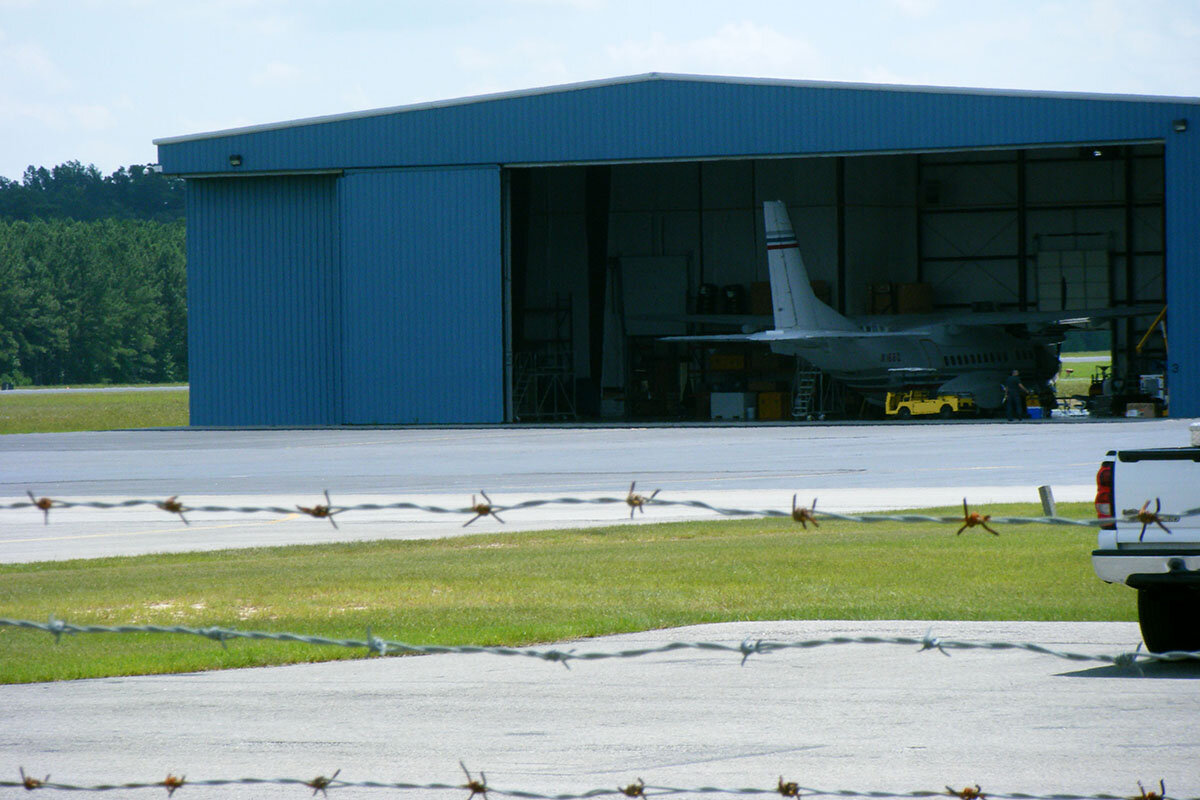
“I want the United States to be a country that respects human rights instead of just lecturing others about them,” says Ms. Cowger, an agricultural scientist and a board member of the North Carolina Commission of Inquiry on Torture. “This was an egregious example of the United States moving the goal posts after 9/11.”
The yearslong work of that citizen-led truth commission concluded in 2018 that at least 34 of 119 known CIA detainees were rendered to CIA black sites on Aero flights from North Carolina; at least 15 others were rendered to foreign custody to be tortured.
Mohamedou Ould Slahi, who was renditioned from Mauritania to Jordan and Afghanistan, testified before the commission that he was held 14 years without charge at the U.S. Guantánamo base in Cuba. Mr. Slahi, whose 2015 memoir “Guantánamo Diary” was the basis for the film “The Mauritanian,” says he was tortured in Jordan and at Guantánamo.
It troubles Ms. Cowger that two decades on from 9/11, the U.S. – unlike Britain, Sweden, and Canada – has neither apologized nor compensated anybody for denying due process to innocent people. In 2017, on the eve of a jury trial, the two psychologists who masterminded “enhanced interrogation techniques” settled an ACLU lawsuit filed on behalf of three torture victims. Guantánamo Bay still holds 39 men, only two of whom have been convicted by a military commission war court.
“We designed this [rendition] program specifically to torture people outside the rule of law,” says Ms. Cowger. “It was a deliberate policy.”
There have been some corrective steps. President Barack Obama acknowledged the use of torture and banned it and extraordinary renditions. In 2015, Congress passed legislation outlawing enhanced interrogation techniques. When President Donald Trump flirted with reintroduction, he encountered bipartisan pushback.
Widespread values shift
Suicide bombers can’t be deterred; they are willing to die for their cause, and 9/11 showed how high the stakes could be, says Johannes Thimm, an analyst at the German Institute for International and Security Affairs. Intelligence agencies can only try to prevent suicide attacks, he adds, and “since that is very difficult to do, they have expanded their powers at the expense of civil liberties.”
In the post-9/11 era, both Al Qaeda and the Islamic State group (ISIS) staged attacks in Europe. In their wake, as in the U.S., watchlists mushroomed, focusing on Muslims. Security services won greater leeway to conduct surveillance, and some emergency powers, notably in France, were codified into law. Across Europe, laws emerged that made individuals criminally liable for their thoughts and words, not just for their actions.
“Gradually we understood what the Americans put in place,” says Mr. Lalam, the terrorism expert. “9/11 had a very strong impact on European legislation. We don’t have a Guantánamo in Europe, but there are politicians who float the idea of special camps for radicalized individuals.”
Another dilemma for intelligence leaders in Europe is what to do with hundreds of their citizens who joined ISIS and were left stranded in Syria after the collapse of its so-called caliphate. Some see troubling echoes of Guantánamo in the refusal of many nations to take them back, leaving over 600 children in dire conditions.

As U.S. allies in the war on terror, European intelligence services have confronted ethical dilemmas. Whether to share intelligence that could result in a person being tortured or killed in an area with no active hostilities is a tough one. Germany takes the U.S. at its word that American bases there aren’t used to carry out lethal drone strikes.
“It is essential while countering terrorism not to leave the democratic and legal order that you want to defend,” says Michael Kowalski, a Dutch expert in counterterrorism and ethics. “Values definitely shifted.”
U.S. targeted killings are evidence of that shift, says Mr. Kowalski, even though they may be lawful and reasonable in certain contexts. Before 9/11, President Bill Clinton boasted he’d had a chance to kill Mr. bin Laden but passed because the attack would have killed innocents. “That standard was abandoned,” says Mr. Kowalski.
Drone killings started in Afghanistan under President George W. Bush. Airstrikes – mostly through drones – increased from 57 under Mr. Bush to 563 under Mr. Obama, according to data compiled by the Bureau of Investigative Journalism. They continued with greater secrecy, a wider geographic range, and less deliberation and transparency over civilian casualties under Mr. Trump.
U.S. counterterrorism policymakers began to prioritize locating and killing terrorists over infiltrating terrorist networks, says Mr. London, the former CIA officer.* The problem with this strategy is that it eliminated the possibility of gathering intelligence from captives and caused Al Qaeda and ISIS to disperse forces. The battle, once focused on the Taliban in Afghanistan and Pakistan, now has multiple fronts, from Nigeria to Indonesia. As the U.S. shifts responsibility to local partners, some worry security assistance delivered with counterterrorism logic is used to repress local populations.
“We don’t want to be the bad guy”
Human rights and counterterrorism haven’t made easy bedfellows, despite the best efforts of people like Fionnuala Ní Aoláin, a United Nations special rapporteur. Prior to 9/11, she notes, terrorism was seen as a domestic concern. Today many nations take advantage of the lack of any common definition of terrorism and the “permissive environment” created by 9/11 to trample on fundamental freedoms, she says.
Counterterror infrastructure grew in the U.S. and at the U.N., and the security lens spread to other areas such as health and education. “That’s the legacy of 9/11. We have securitized everything,” she says.
An overly securitized response – or one that is not appropriately targeted – risks creating more terrorists than those that are killed or captured, warns Eric Rosand, an expert on countering and preventing violent extremism at the London-based Royal United Services Institute. “Whether it’s Guantanamo or jailing political opponents under counterterrorism law ... you are generating more grievances in communities that then can lead to violence,” he says.
Under President Joe Biden, the U.S. finally – and abruptly – pulled out of Afghanistan last month, losing 13 U.S. service members in the process. Mr. Rosand considers the withdrawal an acknowledgment that “20 years of military engagement and security assistance hasn’t led to much.”
“The United States certainly tarnished its reputation as a beacon of values,” says former CIA officer Mr. London. “It’s a country that has made some serious mistakes for which it should be accountable. But I think the fact that we have had that conversation in the United States is a reflection of what we are fundamentally. We don’t want to be the bad guy.”
Editor’s note: This story has been corrected to show that Douglas London is a former CIA officer.

How 9/11 ‘clash of civilizations’ brought East and West closer
The 9/11 attacks were, fundamentally, a shocking expression of clashing values. But, a generation later, under the radar of conflict, there is evidence of greater global understanding and common values.

- Quick Read
- Deep Read ( 9 Min. )
In 2009, teenager Lama Al Nasser came from Saudi Arabia to Michigan for a year of high school through an American government exchange created in response to 9/11 and the belief of an emerging West-East “clash of civilizations.”
Back home she was warned to expect racism “because I was an Arab, and especially Muslim,” she says. But, she adds, the small village of New Lothrop “was completely opposite to what I was prepared for.” She stayed with a loving farm family, played sports, volunteered, and soon knew everyone in town. “People were curious because they wanted to learn,” she says. “It really taught me not to have expectations or be judgmental.”
Her experience in the post-9/11 boom in global, cross-cultural embraces suggests that rather than a clash, geographic and cultural boundaries between the West and the Arab and Muslim world have blurred. A meeting of minds has led to a recognition of common bonds and, increasingly, common values.
“There is no clash of civilizations; it has been debunked by social science and data, which has shown that most conflicts happen within a civilization, not between them,” says Jocelyne Cesari, a religion and politics scholar at the University of Birmingham in England.
How 9/11 ‘clash of civilizations’ brought East and West closer

Rezaul Karim can trace his English teaching career back to a single day walking back from the rice paddies in his village, Nizkabilpur Khiyarpara, in northern Bangladesh.
As he and his father approached the village store, they found a crowd gathering around a battery-operated TV.
Mr. Karim stopped and watched with the crowd, as a second plane hit the World Trade Center. People yelled in Bengali, “America is under attack!” as New York – a city he had only heard of in films – was in flames. He was struck by the horror – the words of the people being interviewed on the Manhattan streets stirred something inside him. He wanted to learn English. He wanted to know America.
A letter to Voice of America resulted in booklets, pamphlets, a notebook, and pencil. With the arrival of electricity and internet in his village in 2010, he made American friends online – Thomas in Virginia, Paul in Texas, William in California – who sent him books on Texas cowboys and on Lincoln and Kennedy, and the classic “The Grapes of Wrath.”
The self-taught Mr. Karim became so proficient that despite not having obtained a college degree, he was employed as an English teacher – a post he held until the COVID-19 pandemic shuttered schools last year.
“Although I never visited, I have been touched by America and Americans,” Mr. Karim says.
Mr. Karim and his American friends are part of an increasing, friendly, global connection that flies under the radar of conventional wisdom that the 9/11 attacks were the first shot in a wider “clash of civilizations.”
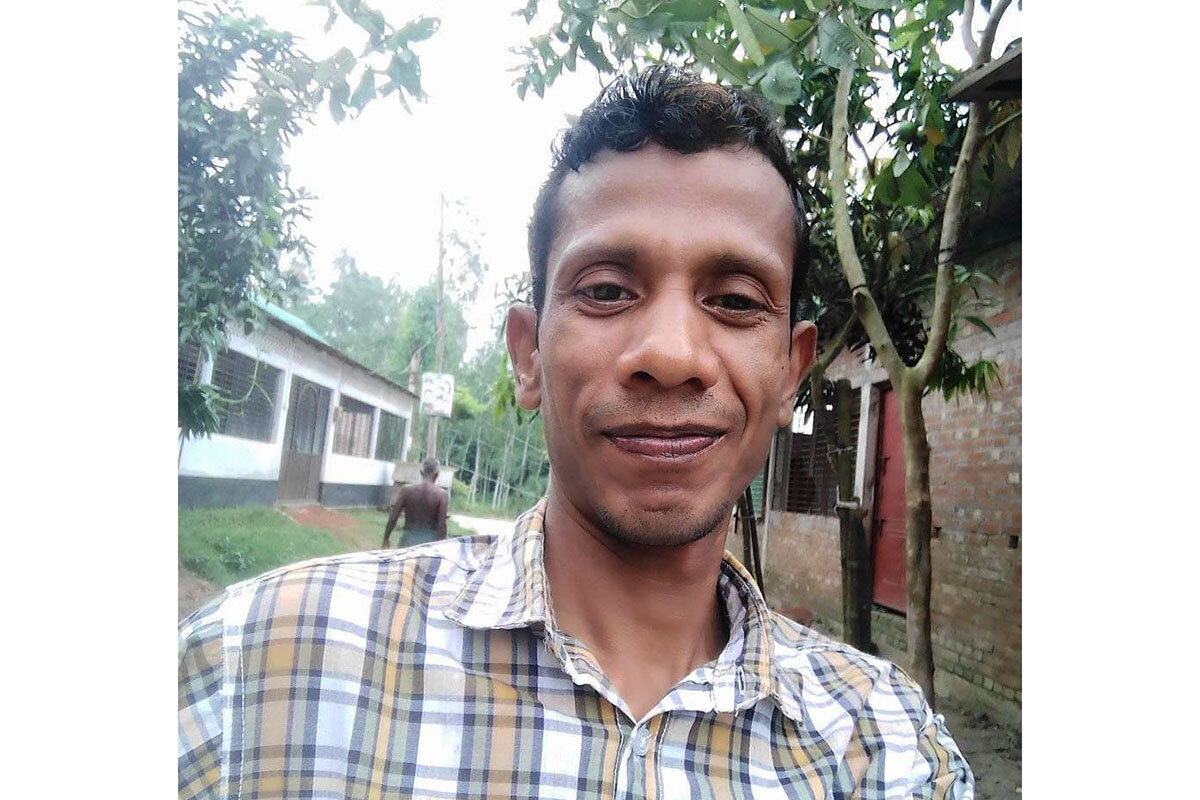
Rather than a clash, whether by design, desire, or simple technological evolution, the geographic and cultural boundaries between the West and the Arab and Muslim world have blurred, as a meeting of minds has led to a recognition of common bonds and, increasingly, common values.
“The idea that the values between the West and the Muslim world are not the same as and are opposed to one another is historically wrong,” says Jocelyne Cesari, a religion and politics scholar at the University of Birmingham in England and a senior fellow at Georgetown University’s Berkley Center for Religion, Peace and World Affairs.
“There is no clash of civilizations; it has been debunked by social science and data, which has shown that most conflicts happen within a civilization, not between them. But this thinking persists because people often use stereotypes to base their views of the other,” she says. “Individual people are breaking the stereotypes by reaching out to one another. But what is missing is the political and religious leadership” to back it up.
After multiple global financial crises, a pandemic, democracy under threat, and United States-China competition, it may be hard to believe that at the turn of the century, before 9/11, a top concern in America was an emerging West-East cultural clash. Some politicians and pundits claimed it was a realization of what Harvard University professor and political theorist Samuel Huntington had coined in 1996 as a “clash of civilizations,” a future in which wars would not be fought between nation-states, but between warring cultures.
President George W. Bush characterized terrorist moves this way: “They hate our freedoms.” It was mistakenly applied by some to encompass an entire region, a belief that the West and the Arab and Muslim world had opposite, conflicting values.
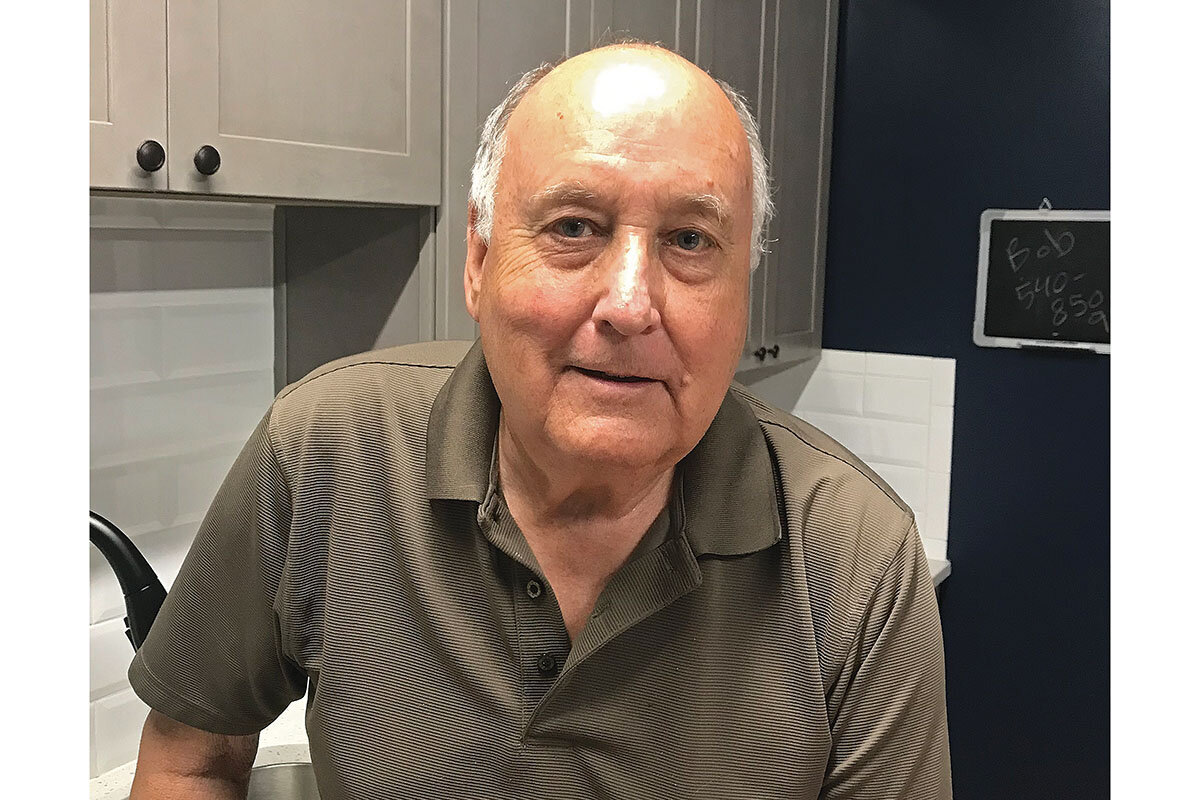
An unexpected embrace
As a response to 9/11, U.S. institutions and the government initiated exchange programs, bringing Arab and Muslim students, journalists, and academics to the U.S. – a soft-power approach to a region where the U.S. was embroiled in multiple wars.
Lama Al Nasser is one of hundreds who took part. The Saudi clinical psychologist came to the U.S. as a 15-year-old for a year of high school through the Kennedy-Lugar Youth Exchange & Study Abroad program in 2009. She was to be an ambassador for her country, race, and religion in an America full of prejudices and stereotypes.
“People back home told me to expect racism because I was an Arab, and especially Muslim,” Ms. Al Nasser says. “Being in a small town means you stand out more. ‘Don’t be too close to anyone. Build your walls,’ they told me.”
Arriving from Riyadh in New Lothrop, a central Michigan village of 600, she says, “was completely opposite to what I was prepared for.”
She stayed with a loving family on a farm and soon knew everyone in town, and they her – from the gas station to the last house on the town limits. Curiosity about the first Arab and Muslim in town led people to welcome her, recalls Ms. Al Nasser: “People were curious because they wanted to learn. Everyone wanted to be friends with me because I was different. It really taught me not to have expectations or be judgmental.”
She engaged in sports from soccer to track – activities then mostly closed to women in Saudi Arabia. She surprised herself by taking second in a 100-meter race: “I never even knew I was good at sports because I had never tried before.”
Volunteering for Habitat for Humanity, helping finish a home for a family Ms. Al Nasser got to know, made her passionate about community service, which at the time wasn’t common in Saudi Arabia. In 2018, she founded We Dream, an association that provides catch-up education, entertainment, and psychosocial support to children and older people in Riyadh hospitals.
“Because of my time in the U.S.,” she says, “I learned that I have so much energy and I need to give to the community, to the people around me, and I carried that spirit with me back home. Deep down, we all want to give back to others less fortunate.”
Multifaceted communication
The past two decades have also seen an explosion in language exchange.
The number of American college students enrolled in Arabic courses doubled from 5,000 in 1998 to 10,500 in 2002, and has averaged 35,000 students over the past 10 years, according to the Modern Languages Association. Meanwhile, English, once an elective, is now a mandatory course from first grade in several Arab countries.
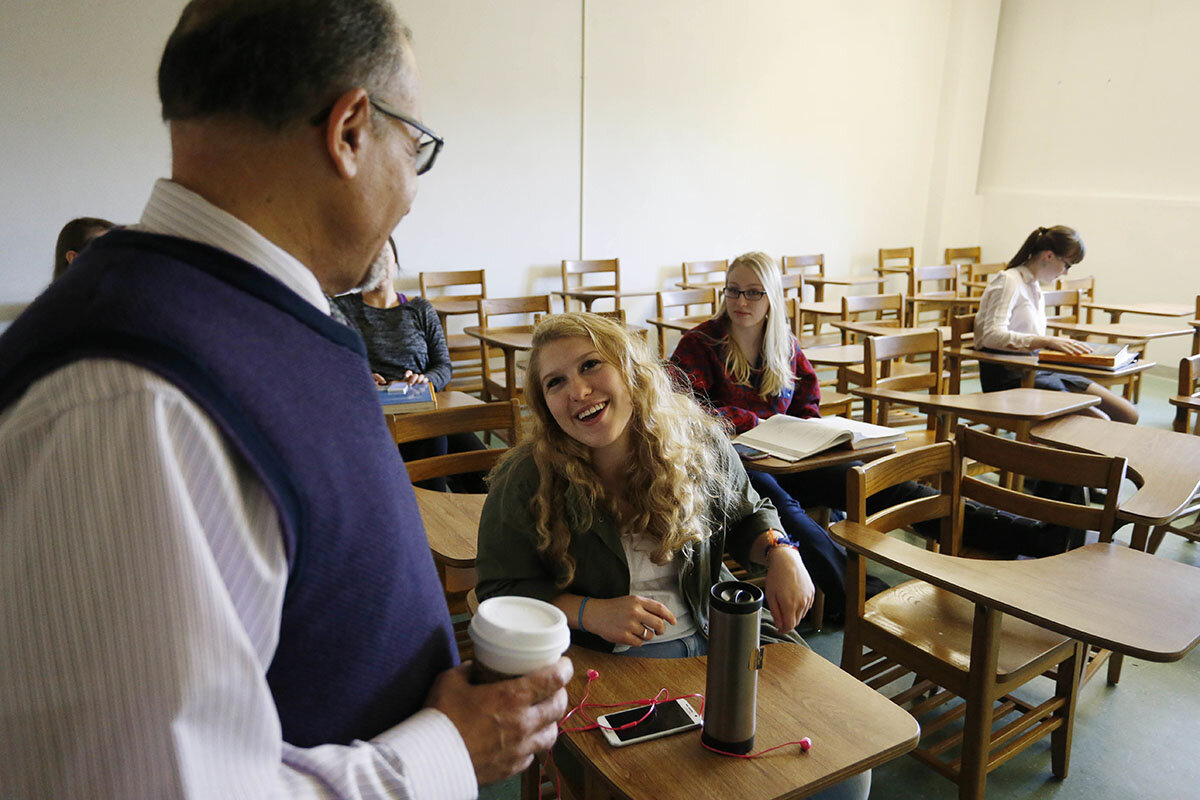
What started as breakthrough person-to-person exchange and diplomacy in the early 2000s have given way to mass connection through social media.
With the swipe of a smartphone, in real time, citizens around the world are connecting to news events and finding common bonds and causes, from climate change to social justice to cooking or gaming.
It’s a trend that has propelled people such as Turkish street drummer Bilal Göregen, who is visually impaired, into international stars. His viral performance of “Ievan Polkka” – itself a Finnish folk song – was seen more than 85 million times on YouTube, and even sampled by Democratic supporters of Joe Biden in the 2020 elections.
It may seem trite to older generations, but some members of Generation Z feel a unity in these viral cultural touchstones.
“We stream the same TV series, play the same video games, listen to the same songs; we use TikTok to express ourselves: We have more in common with members of our generation across the world than we do with the older generations in our own village,” says Amar Saeed, a Jordanian university student and self-described Call of Duty expert, who harbors hopes of becoming a “professional gamer.”
Facebook was the bridge that brought retired American air traffic controller Thomas Pesnicak into conversation with several Bangladeshis, including Mr. Karim.
“Rezaul likes America because he has had one-on-one contact with [me] and a number of different people across America on Facebook,” says Mr. Pesnicak, who has corresponded and video-chatted from Fairfax, Virginia, with Mr. Karim in his village regularly for a decade, and half-jokingly invites him to barbecue at his place every weekend. The American has sent the Bangladeshi books and a radio, and helped him pursue a college degree – and in turn, he has gotten to know Mr. Karim’s village.
“Hearing from regular people from different backgrounds with very different views gives someone a good sense of who we are,” much more than a government policy, military involvement, or politicians, says Mr. Pesnicak. “There will always be hard-liners at the edges of every society sniping at one another, but once people meet and talk, it breaks down barriers and opens up new worlds.”
Such connections also create a symmetry of activism. Amid the protests over the murder of George Floyd by a Minneapolis police officer last summer, Syrians painted murals of Mr. Floyd. And during violent protests and strife over the Palestinian cause this year across the Middle East, Black Lives Matter activists held protests across the U.S. in solidarity with them.
Similar connectedness is apparent to Ms. Al Nasser when advising Saudi students on what to expect as they head to the U.S.: “They tell me, ‘Yeah, we already know this.’ They have the ability to look everything up. They are much more aware than we were a decade ago.”
“All in this together”
Bridges of understanding are being created not only between people, but also through a meeting of minds among faith leaders.
The 9/11 attacks, described by Muslim and Christian faith leaders as a wake-up call, gave a jolt of energy to the faith community, leading to the broadening of interfaith connections from intra-Christian and Christian-Jewish outreach to include Islam, Buddhism, Taoism, Hinduism, and Sikhism.
What began as unified statements denouncing violence in the name of religions quickly grew into an exploration of common bonds and respect for one another’s traditions – and now, joint action.
One of the leading bodies is the G20 Interfaith Forum (IF20), a gathering of leaders and representatives across the world’s religions to discuss common challenges and solutions to climate change, racism, human trafficking, restrictions on religious expression, inequality, and, particularly, the response to COVID-19.
“Interfaith energy is going beyond dialogue, evolving from the mutual desire to recognize and respect each other’s histories, traditions, and contexts to work together in an increasingly bound-together planet,” says the Rev. Dr. James Christie, ambassador at large for the Canadian Multifaith Federation and an IF20 participant. “There is a sense that the world’s religious communities are saying we are all in this together.”
Last year the IF20 summit convened, virtually, from Saudi Arabia, the birthplace of Islam, and produced a statement on structural racism that noted, “The evidence of anthropology and the witness of our sacred texts conclude that all people share a common ancestry. We are all related. Our common heritage forbids that any might claim a racial pre-eminence over another.”
Despite differences, common bonds
But differences and, at times, tensions remain. Resentment over foreign policy still clouds the view of America for some, particularly the issue of Palestinian rights, U.S. military involvement in the region, and perceived U.S. support of oppressive leaders.
Similarly, the American view to the east has been clouded by violent extremism and the emergence of the Islamic State group (ISIS), and Muslims witnessed a spike in anti-Muslim sentiment during the Trump administration’s so-called Muslim ban.
Although global perceptions of the U.S. rose favorably at the time of 9/11, they have declined steadily since. What positive perceptions of America do exist rise and fall with changing U.S. administrations – driven by policy, not values.
Early in the Biden administration, before its abrupt withdrawal from Afghanistan, the U.S. enjoyed rising public favor in Morocco, Libya, Jordan, and Tunisia, according to Arab Barometer.
While individual and faith-based efforts to cross the apparent West-Islam divide are ongoing, they “have not gained the type of visibility that the clash of civilizations is still having in the public discourse,” says Ms. Cesari. “It is part of a public discourse that shapes policymaking to this day.”
The persistent belief that Western and Islamic values are not compatible fuels propaganda for far-right and extremist groups such as Al Qaeda and ISIS, each side “feeding off one another” in a bid to gain followers, she says, while common bonds are often lost in the political debate and media narratives.
Mr. Karim, the teacher, says he still faces criticism from some fellow Bangladeshis who believe the U.S. is “anti-Islam.”
“There are people in Bangladesh who still think that America and Islam can’t get along,” says Mr. Karim. “I have friends who criticize me for appreciating things about America and try to convince me that America is the enemy of Islam around the world, starting wars in Afghanistan, Iraq, and Syria.
“But from talking to American friends and reading the Constitution, I know that the law is open to everyone, there is freedom of religion for everyone, and there are Muslim communities – Muslim Bengalis living peacefully there for a long time,” Mr. Karim says.
“I tell them this: ‘The coin always has two sides,’ and people cannot be judged by the actions of one government or that of a few individuals.”

One town’s beacon of 9/11 kindness: Gander shines on
For all of the tragedy of 9/11 and all the repercussions the world still grapples with, one place has become a symbol of unabashed kindness. And it’s a story that shouldn’t be forgotten as the world finds itself emerging from the pandemic.

- Quick Read
- Deep Read ( 9 Min. )
Even as a third grader on 9/11, Charlotte Gushue knew it “was a very defining moment” reverberating in this small Canadian town 2,300 miles north of the New York attacks.
Commercial flights were suddenly barred from entering American airspace and 38 commercial jets carrying 6,500 passengers landed here. The focus for Gander, Newfoundland, wasn’t the news of terrorism, but how to help: Most in Gander and surrounding towns had a job they could do – taking people into their homes, offering hot showers or a quiet place to reflect, lending cars, tracking down kosher food, helping to refill prescriptions, or caring for pets that had been in cargo.
For days, Ms. Gushue watched her mom tirelessly bake batches of tea buns (see her recipe in the deep read), her parents doing their part to deliver food. No doubt, she says, that’s why she became a baker.
Gander’s heroic kindness became legend, celebrated in a Broadway musical and by tourists still flocking here to meet those who hosted stranded travelers.
“When you look at it, you see two spectrums: What you saw was the worst of mankind in the United States [9/11 attacks] and you probably saw the best of it here,” says Claude Elliott, who was mayor at the time.
One town’s beacon of 9/11 kindness: Gander shines on

Charlotte Gushue was a Canadian third grader when four hijacked airplanes were used to perpetrate the deadliest foreign attack on U.S. soil. She hardly understood it. What she knew was that thousands of passengers, on flights suddenly barred from entering American airspace, landed in this small town in Newfoundland and that she was sent home from school.
A troublemaker back then by her own admission, she read the room and stayed quiet. When her mother, between hurried phone calls, asked her to go up and look through her books and stuffed animals to donate, she was mad.
Teeth gritted, she did it anyway.
Like most children in Gander on 9/11, Charlotte got the rest of the week off from class, as schools immediately turned into shelters. But this was no snow day: Oz Fudge, who was on patrol as police constable, saw kids helping their parents drop off food, clean sheets, and toothbrushes, and some even cleaning toilet bowls.
“It just done the cockles of my heart,” he says.
Charlotte returned with her parents to her school and understood something major was happening: Sleeping on the gym floor were 770 passengers. Cellphones weren’t ubiquitous, and many of them had no idea what had happened until the community set up TV screens. Charlotte witnessed the horror on their faces as the images flickered.
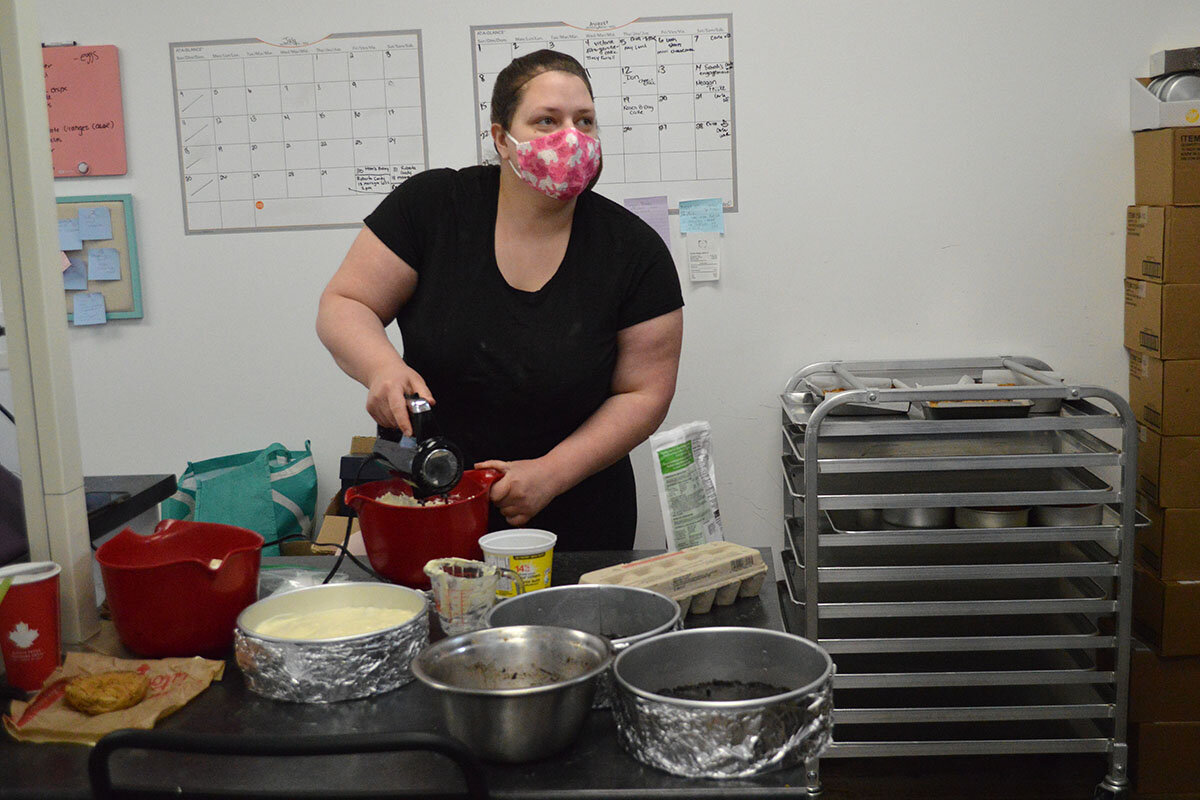
“It’s a hard word to describe,” she takes a long pause. “There was something so big happening. ... And I don’t think my parents actually explained the concept of terrorism. I think the focus wasn’t on that for us, but it was really on what we can do and how we can help because that had to be a priority for everyone at that time.”
Over the next five days, she watched her mom tirelessly bake batches of tea buns and muffins, her parents doing their part to deliver food. She has no doubt that’s why she became a baker.
In a flour-dusted outfit in her sweet little “Cookie Starts With C” shop she just opened off the main stretch, Ms. Gushue also has no doubt that it set the tone for what she hopes the bakery will mean for the community. She’s cultivating the basic goodness Gander came to encapsulate on 9/11 – goodness that’s captured the world’s attention ever since.
“It was a very defining moment, even at age 8,” she says.
Gander may not look like much from the ground. The Trans-Canada Highway passes beside it, and motorists can get what they need without even turning into town.
From high in the sky it’s different: Planners built periphery streets in the shape of a goose head discernible from above. For Gander, it’s the airspace that matters, anyway: The airport – opened in 1938 – was a staging point for World War II Allies, and later, a refueling stop for transatlantic jets.
So, it was a logical landing point during 9/11: Gander received 38 commercial jets carrying about 6,500 passengers – half the number of the town’s entire population. Most in Gander and surrounding towns had a job they could do – taking people into their homes, offering hot showers or a quiet place to reflect, lending their cars, tracking down kosher food, helping to refill prescriptions, or taking care of pets that had been in cargo.
“We saw people from 95 countries that needed help. And we poured out love and compassion for complete strangers because that’s what we would want if we were stranded in their place,” says Claude Elliott, who was mayor at the time. “They couldn’t believe that complete strangers would bring them into their homes and say, ‘Hey, you know, just sit there. I’m going to work; you stay here for the day, take my car, go for a ride.’ They asked, ‘Is this real?’ But, you know, that’s the way we live here.”
Those actions, he says, were instinctive well before 9/11, on a rugged island where you stick together to survive. But since then, they’ve defined this town – inspiring the hit Broadway musical “Come From Away” – and have re-instilled simple lessons that 20 years later, and in the face of the pandemic, perhaps resonate even more now.
“When you look at it, you see two spectrums: What you saw was the worst of mankind in the United States [9/11 attacks] and you probably saw the best of it here,” says Mr. Elliott. “The more of that good news story we can get out, no matter what the story is, it’s good – get it out, because it seems harder to get the good out than the bad.”
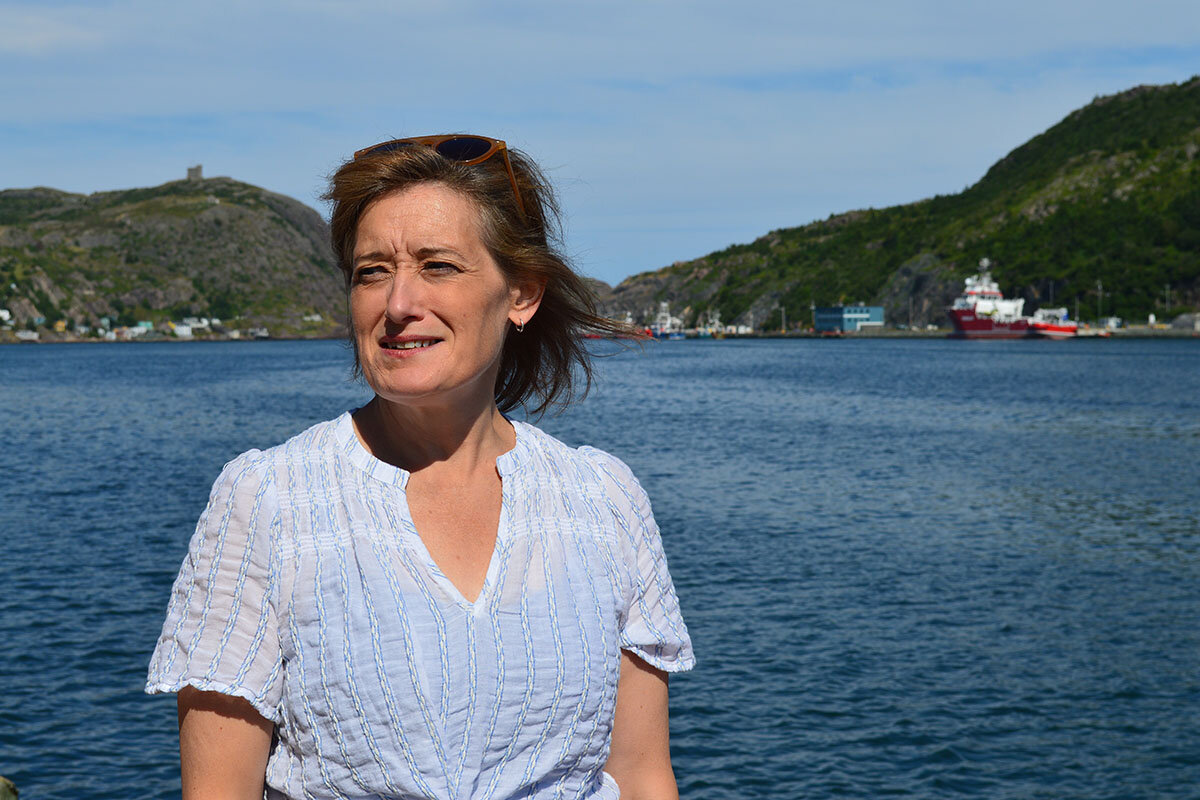
Small offerings add up
For host and guest alike, the story doesn’t end on 9/11, but continues to reverberate. Kevin Tuerff, an American in Austin, Texas, was a passenger on his way back from Paris on 9/11 when his flight was diverted here. He still remembers the simplest gesture: a young boy handing him an air mattress, comfort from the cold floor.
“It’s a very humbling experience to be a recipient of kindness,” he says. It made such an impression that he started a “pay it forward” day at his company. Today it has grown into a “kindness” charity, Pay It Forward 9/11, that this year is focusing on random acts of kindness that forge unity – the kind the U.S. said it wouldn’t forget after 9/11 but so clearly has in its riven politics, says Mr. Tuerff.
That boy who gave him the mattress – which quickly deflated, but that’s beside the point, he says – would’ve been around Ms. Gushue’s age. It’s fitting – although coincidental – that when you walk into Cookie Starts With C, the first thing you see is a big bulletin board, with the words “Pay it Forward” painted in black cursive above it, where residents can buy treats for a stranger. One index card attached with a pushpin reads, “1 piece of Cheesecake. For: A police officer.” Another: “Muffin and Medium specialty tea or a coffee. To a mom who is just surviving.”
It sets the tone for the place Ms. Gushue wants her bakery to be – a tone that harks back to elementary school, she says: “With 9/11, my parents just brought sandwiches, books, muffins. Like, it doesn’t seem like a lot, but a simple offer of a hot shower or a comfortable bed can mean a lot. That all kind of funnels through my life. We can do a lot of small things and they add up to be really big things for a lot of people.”
Diane Davis was Ms. Gushue’s teacher on 9/11. She says this very lesson, which her former pupil is carrying forward, is one that she learned herself from 9/11.
The retired teacher has helped sponsor Syrian refugees in Gander. They often thank her with food. But sometimes they bring her gift cards for gasoline. “The first time it happened, I was upset, because they don’t make a lot of money. I’ve done it my whole life, said, ‘No, you don’t have to.’ But I realized that I take away their opportunity to get satisfaction from that,” she says. “So now I take it and say thank you.”
She tears up as she recounts the five days she spent helping to house, feed, and care for so many others. But she’s hardly the only one who feels 9/11 right at the surface.
A musical about 9/11?
“Come From Away” has added a whole new dimension to the Gander narrative.
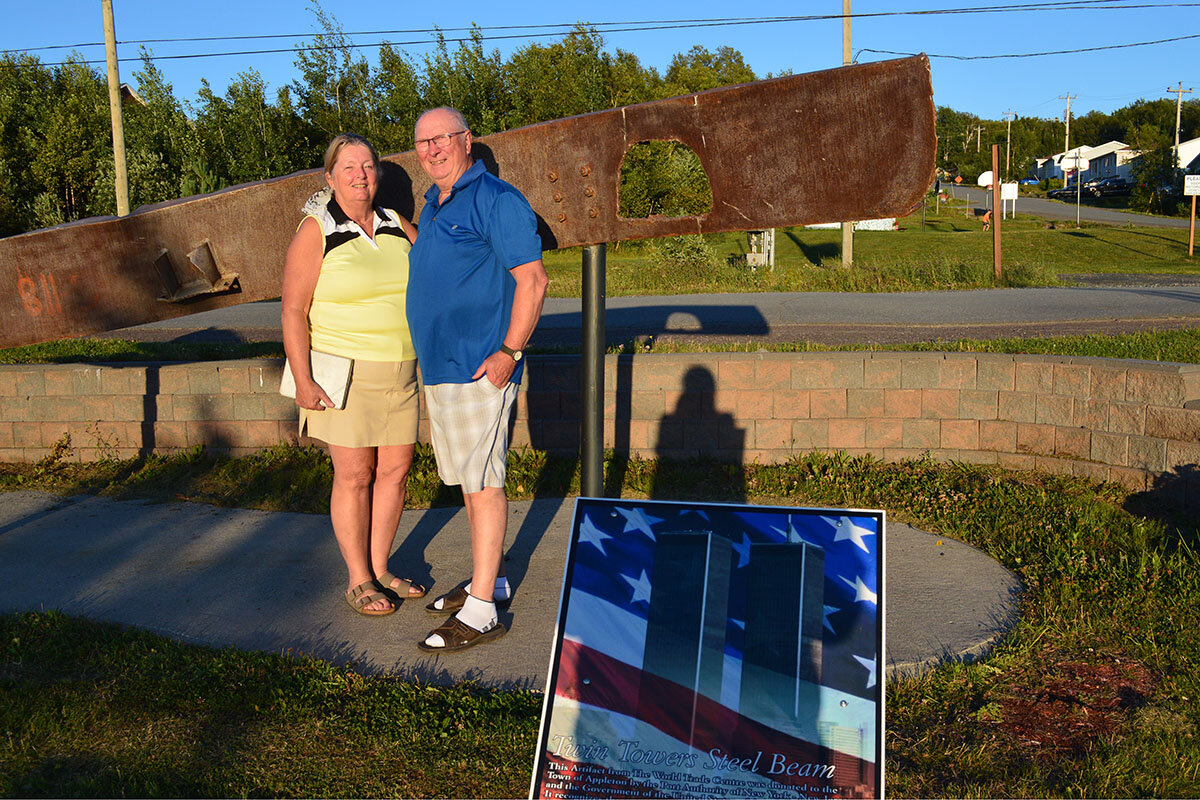
Derm Flynn – who at the time was the mayor of nearby Appleton and is portrayed in the musical as well as Ms. Davis, Mr. Elliott, and Mr. Fudge – says that when he heard a production was in the works, he had thoughts that “weren’t very nice, actually.” “We thought, ‘Well, how can you write a musical about 9/11?’ It’s almost sacrilegious. ... And also, ‘How can you write a musical about people giving someone a bowl of soup and a sandwich ... normal things that you would do anyhow?’”
Mr. Flynn explains that he was surprised by how wrong he was. His kitchen, where he was interviewed while cooking cod he’d just caught, is full of “Come From Away” memorabilia. The musical has kindled such fresh interest in Gander and surrounding towns that also welcomed passengers that he and his wife, Dianne, began offering tours of their home called “Meet the Flynns.”
The tour includes their story of the first night of the jet groundings here: The couple, now married more than 50 years, didn’t communicate that each separately had invited three people to stay with them, and the resulting collision of kindness had all six stranded passengers squeezed in on air mattresses and a chesterfield sofa. One of them became such a close family friend that the Flynns were the second people he called on the birth of his first child in New Jersey.
About 100 tourists have visited the Flynn home to revel in these tales.
What 9/11 summoned, COVID suppressed
A yearning for the Gander story is not surprising given the backdrop of something as unimaginable as 9/11, or given global pandemic repercussions today, says Jennifer Mascaro, lead scientist in the department of spiritual health at Emory University, in Atlanta.
“In dealing with trauma, both at the individual level and at the societal level, people try to make meaning and coherence that is positive in nature, soothing in nature, empowering in nature,” she says.
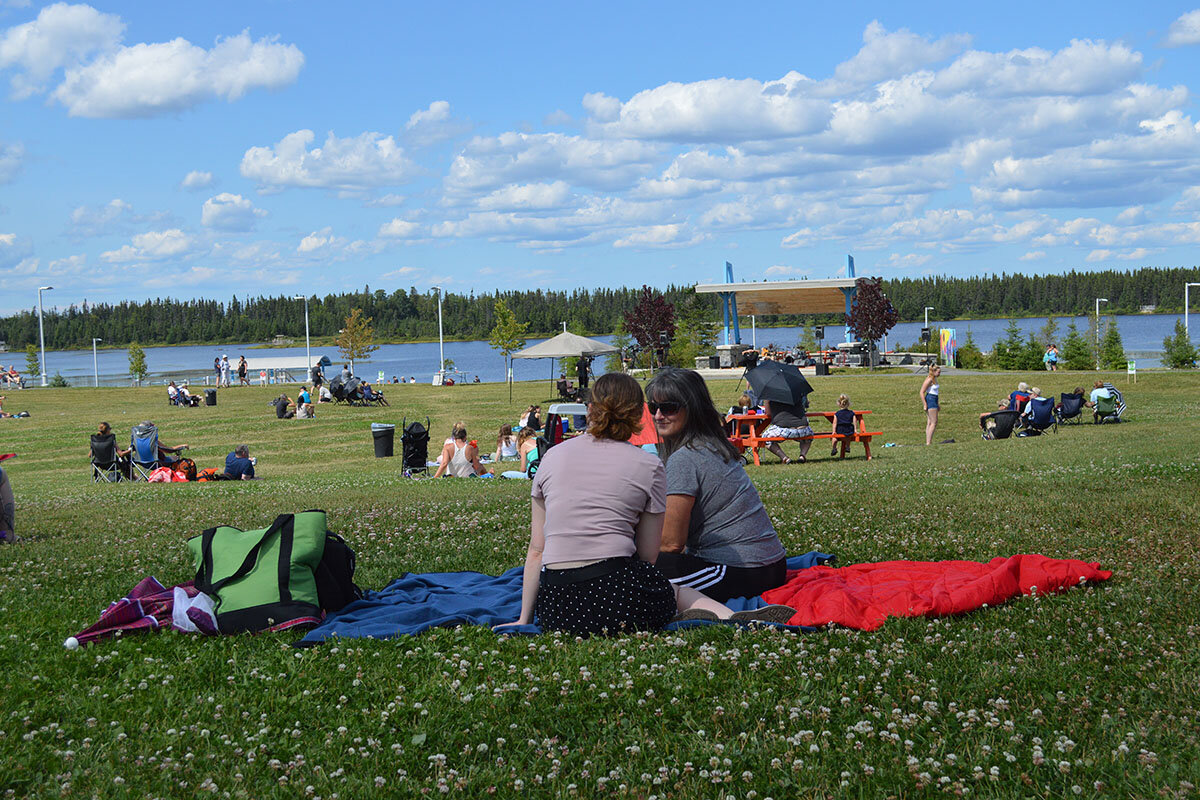
Gander Day, in August, was one of the first civic gatherings after Canada’s post-pandemic reopening. Mayor Percy Farwell welcomed back Gander citizens who’d gathered to listen to live music – much of it odes to tough island life. He said their actions on 9/11 were natural and that pandemic restrictions contradicted that basic nature: “When the best thing you can do for someone is stay away from them, that’s hard for us to get our heads around.”
Because of the pandemic, 9/11 anniversary commemorations – including a production of “Come From Away” – have been scaled back. But Mr. Fudge, now a Gander councilor, is sure it’ll happen next year: “[The story] reminds people that this is the way we should be living, where your neighbors worried about you. And I think people are looking for that something to hold onto, that light in the window, and they are saying, ‘I’d like to be able to get there.’”
He’s probably right: When “Come From Away” reopened in London in July, the cast had to hold for applause after the opening act for a minute.
“Usually, we hold for three to five seconds, and we are out,” says Petrina Bromley, a Broadway actor in the show who is from Newfoundland.
She expects the same reaction when the Broadway production is set to resume Sept. 21. “So many people have been through so much in the past year and a half,” she says.
“So, a little story about being nice to people goes a long way.”

TEA BUNS – THE GANDER WAY
Gander third grader Charlotte Gushue helped her mom make tea buns for stranded airline passengers in the wake of the 9/11 attacks. Here is her family’s favorite recipe for the scone-like tea buns – a version of which is sometimes on offer at the bakery she grew up to run.
Ingredients
2½ cups all-purpose flour
1/2 cup coconut
1/2 pound butter (1 cup)
1/2 cup sugar
6 teaspoons baking powder
2 teaspoons custard powder
1/3 cup chopped dried apricots
1/3 cup mixed fruit
2 eggs
3/4 cup milk
Directions
Put the first six ingredients in a bowl.
Crumble together and add apricots and mixed fruit.
Make a well and add eggs and milk.
Mix lightly. Spread on floured board.
Cut and place on a greased baking sheet.
Bake at 450 degrees for 15 minutes.
* Editor’s note: The dough is very sticky. Instant vanilla pudding or cornstarch are substitutes for custard powder.

Listen
Coming of age after 9/11: Muslim millennials sense progress
Becoming an adult in post-9/11 Western society wasn’t easy for young Muslims. In this podcast conversation, Monitor journalists Husna Haq and Shafi Musaddique discuss the cultural progress and setbacks that shaped their views of country and self.
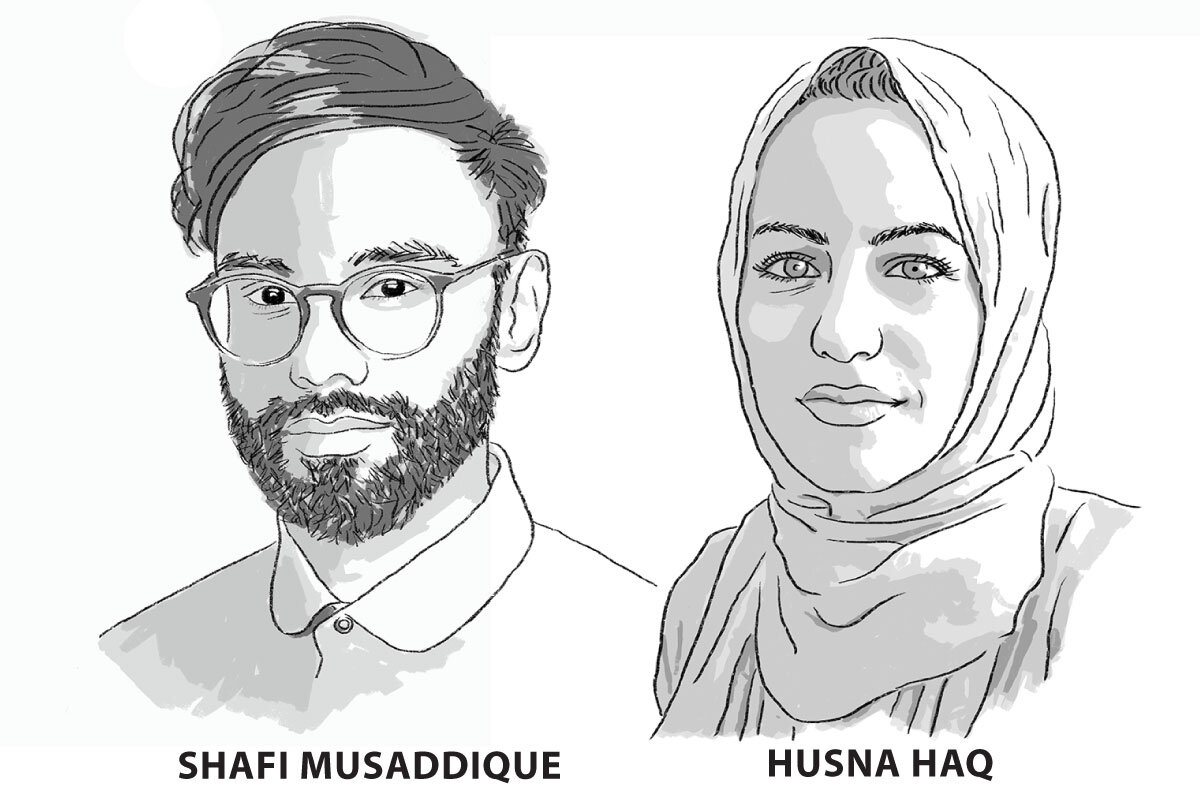
In a small town in Pennsylvania, a young Muslim woman wearing a hijab walked into a mom and pop store and struck up a conversation with the owner. She’d just moved from New York state to start her first reporting job after college. The next day, a police officer showed up at her office. The store owner had reported suspicious behavior.
Husna Haq, now a Monitor editor, says that experience in 2005 is a reminder about how life after 9/11 was different from before: “I was already used to the funny looks or the stares. But I think 9/11 just turned the volume way up.”
The Monitor’s London correspondent Shafi Musaddique was 10 years old at the time of 9/11. But he, like Ms. Haq, experienced the shift as “a flick of a switch,” he says. “Because of 9/11 we became this homogeneous group.” And yet, he notes, “Muslims are a myriad of thoughts and ideas. We’re not always victims. We’re not always perpetrators.”
As the world reflects on 20 years of loss and conflict since the 9/11 attacks, Ms. Haq and Mr. Musaddique look back in a Monitor interview at how Western views of Islam and Muslims shaped their view of faith, country, and self. – Ashley Lisenby, staff writer
This story was designed to be heard. We strongly encourage you to experience it with your ears (audio player below), but we understand that is not an option for everybody. A transcript is available here.
Reflections on Being Muslim in the Aftermath of 9/11

The Explainer
The 9/11 effect: By the numbers
The 9/11 attacks echo through much of American life. Our infographic highlights large and small effects: From national policy to personal policy, 9/11 has changed the way we do things.
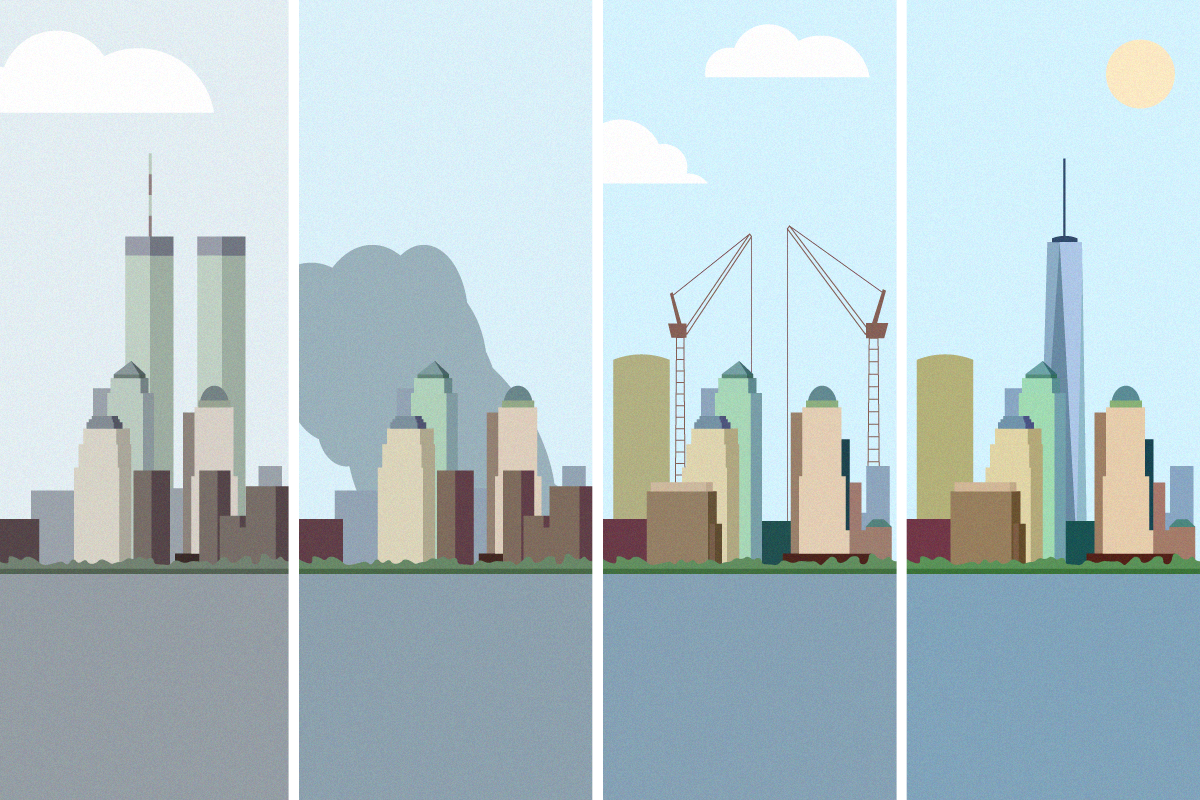
- Quick Read
- Deep Read ( 1 Min. )
-
Jacob Turcotte Staff
-
Jingnan Peng Multimedia Producer
Sept. 12, 2001. That day is less referenced, but it marked the beginning of the legacy of recovery, change, and revitalization.
Twenty years and two wars later, the shifts in national security, charitable giving, and in communities are a part of the bedrock of American life today.
For example, John Bridgeland, who led the Bush White House civic service effort, calls Sept. 11 a “turning point.” The nation’s sense of unity was unprecedented. In the short term, citizen service rose sharply, he says.
“We have to build on the legacy of 9/11,” says Mr. Bridgeland, “to usher in a generation of commitment to civic renewal.”
Watch the video below or click the “deep read” button above to explore the full data.
The 9/11 effect: By the numbers
Sept. 12, 2001. That day is less referenced, but it marked the beginning of the legacy of recovery, change, and revitalization.
Twenty years and two wars later, the shifts in national security, charitable giving, and communities are a part of the bedrock of American life today.
For example, John Bridgeland, who led the Bush White House civic service effort, calls Sept. 11 a “turning point.” The nation’s sense of unity was unprecedented. In the short term, citizen service rose sharply, he says.
“We have to build on the legacy of 9/11 and the growth we saw in service and volunteering programs to usher in a generation of commitment to civic renewal at a time when our country needs it more than ever,” says Mr. Bridgeland.
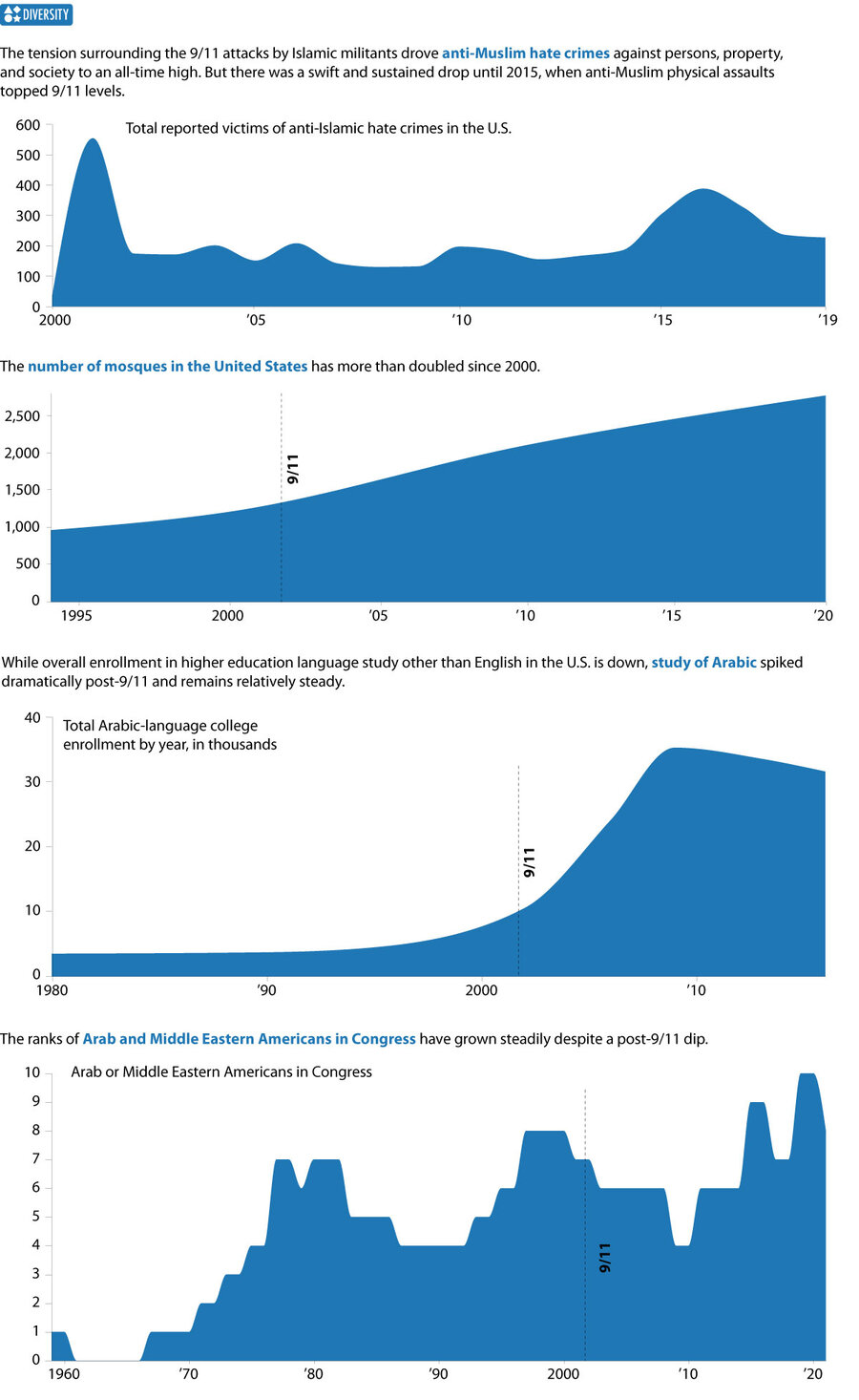
FBI Uniform Crime Reporting Program, Institute for Social Policy and Understanding, Anadolu Agency, Modern Language Association, Arab American Institute, Arab American Leadership Council
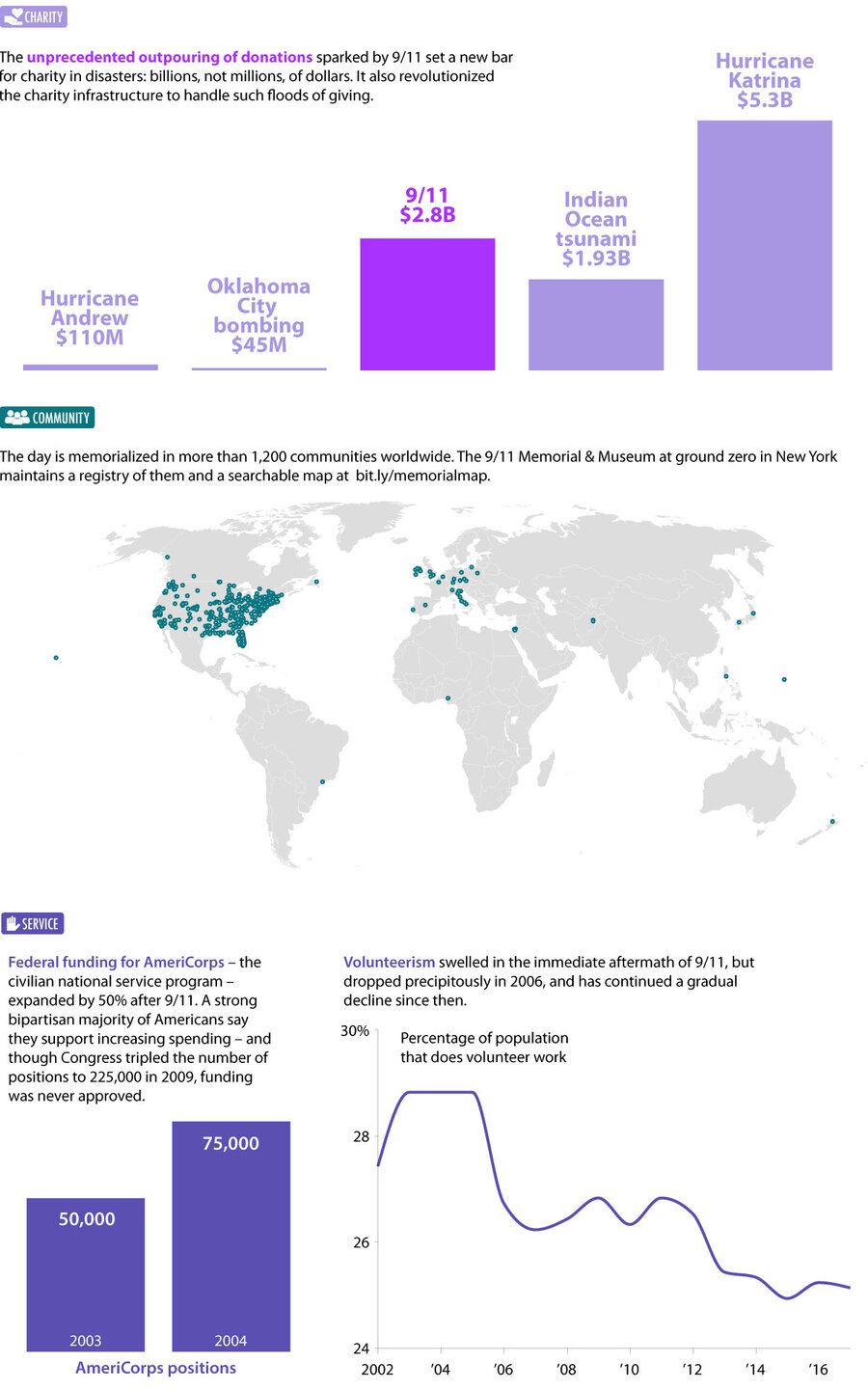
GovInfo, Chronicle of Philanthropy, Lilly Family Center on Philanthropy at Indiana University, 9/11 Memorial & Museum, America's Service Commissions, U.S. Bureau of Labor Statistics
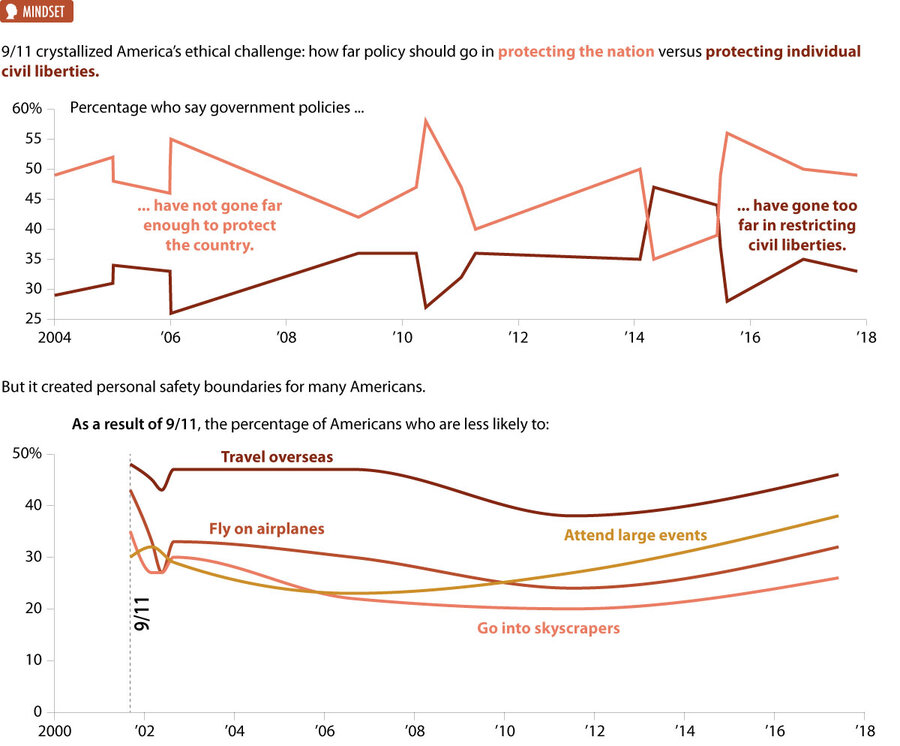
Pew Research Center, Gallup
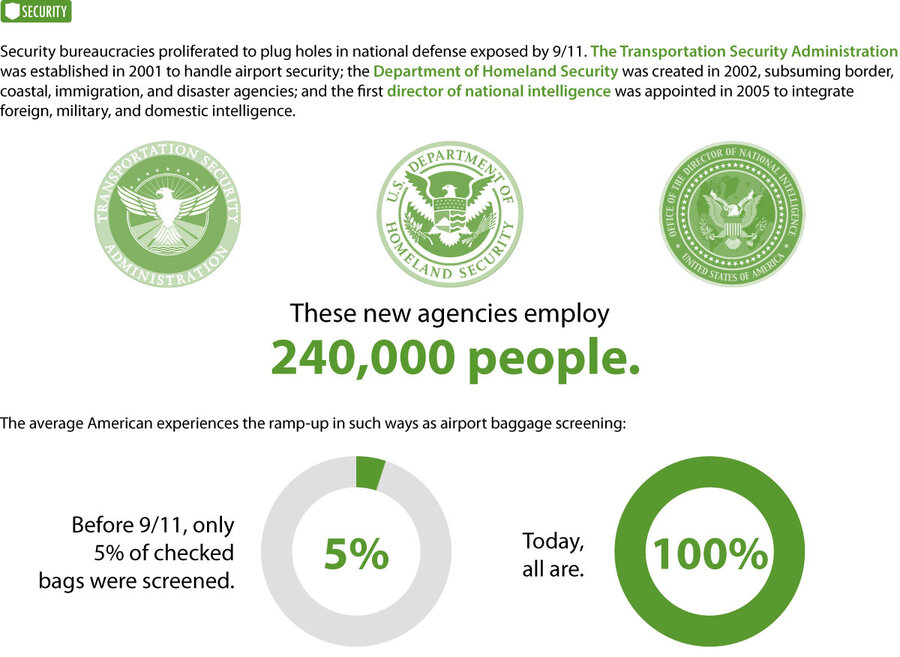
Department of Homeland Security, NPR
Christmas caroling: An animated essay
Other headline stories we’re watching
(Get live updates throughout the day.)The Monitor's View
Women’s role in a post-9/11 world
- Quick Read
- Deep Read ( 2 Min. )
-
By the Monitor's Editorial Board
Soon after the 9/11 attacks in 2001, many commentators noted a particular aspect of the 19 hijackers: None were women. That simplistic view of women as anti-terrorist has lessened over the past 20 years. Hundreds of women have since conducted suicide bombings or attempted them for extremist groups. Many more have recruited young fighters. Yet just as compelling has been another trend: More women are leading efforts to defeat terrorism, often by giving early warnings of an attack or promoting counternarratives to violent jihadi ideology within families and communities.
At the United Nations, meanwhile, the Security Council has passed resolutions encouraging nations to empower women in the prevention of violent extremism, especially as mediators and negotiators for peace. “After nearly two decades of ongoing efforts to defeat terrorism, the international community has learned that it must engage women as positive actors in their comprehensive strategies to tackle drivers of violent extremism and counter radicalization,” states a commentary by the United States Institute of Peace.
Twenty years on, one lesson from 9/11 is that women can and should be leaders for peace.
Women’s role in a post-9/11 world
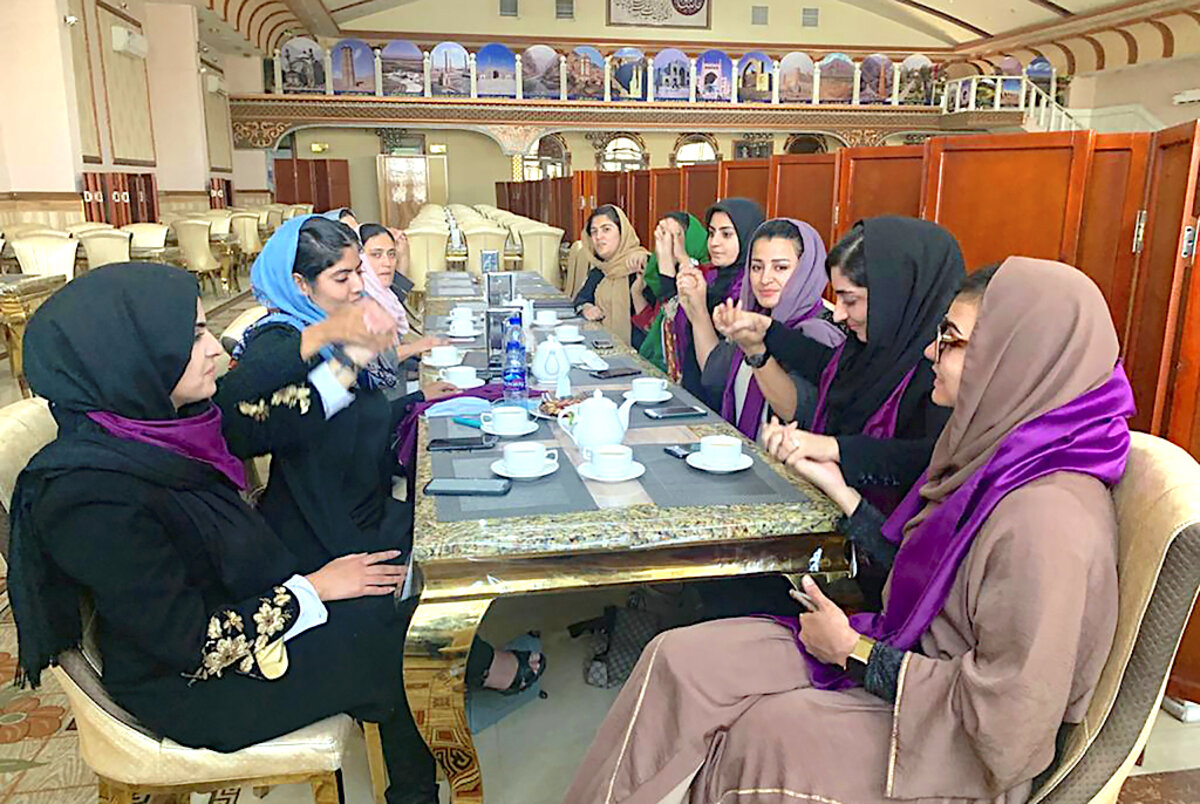
Soon after the 9/11 attacks in 2001, many commentators noted a particular aspect of the 19 hijackers: None were women. That simplistic view of women as anti-terrorist has lessened over the past 20 years. Hundreds of women have since conducted suicide bombings or attempted them for extremist groups. Many more have recruited young fighters, especially for the Islamic State group. Yet just as compelling since 9/11 has been another trend: More women are leading efforts to defeat terrorism, often by giving early warnings of an attack or promoting counternarratives to violent jihadi ideology within families and communities.
In Morocco, for example, Muslim women have been trained as preachers to espouse moderate interpretations of religious teachings. In Kenya, a civil society group called Sisters Without Borders trains women-led organizations in helping governments prevent terrorist attacks. In Sudan, women led protests that ousted a terrorist-promoting dictator. Female protesters in Iran have demanded that leaders stop backing foreign terrorist groups.
“Because of their distinctive access and influence, women are crucial antiterrorism messengers in schools, religious institutions, social environments, and local government,” Jamille Bigio, a former fellow at the Council on Foreign Relations and now a top USAID official, told Congress two years ago. Women are particularly sensitive to signs of radicalization, says Ms. Bigio, “because attacks on their rights and physical autonomy are often the first indication of a rise in fundamentalism.”
At the United Nations, meanwhile, the Security Council has passed resolutions encouraging nations to empower women in the prevention of violent extremism, especially as mediators and negotiators for peace. “After nearly two decades of ongoing efforts to defeat terrorism, the international community has learned that it must engage women as positive actors in their comprehensive strategies to tackle drivers of violent extremism and counter radicalization,” states a commentary by the United States Institute of Peace.
Twenty years on, one lesson from 9/11 is that women can and should be leaders for peace. The more they are empowered to save innocent lives, the more they will be recognized for saving innocent lives.

A Christian Science Perspective
Each weekday, the Monitor includes one clearly labeled religious article offering spiritual insight on contemporary issues, including the news. The publication – in its various forms – is produced for anyone who cares about the progress of the human endeavor around the world and seeks news reported with compassion, intelligence, and an essentially constructive lens. For many, that caring has religious roots. For many, it does not. The Monitor has always embraced both audiences. The Monitor is owned by a church – The First Church of Christ, Scientist, in Boston – whose founder was concerned with both the state of the world and the quality of available news.
Conquering hate
- Quick Read
- Read or Listen ( 3 Min. )
-
By Barbara Vining
Sometimes – especially in the aftermath of violence or other atrocities – the pull of hatred can feel irresistible. But with God’s help we can rid ourselves of hateful thoughts, overcome a tendency to return hate for hate, and witness the healing power of divine Love.
Conquering hate
Many emotions linger in connection with the horrific attacks on American soil on Sept. 11, 2001. Among them is the temptation to hate.
Christ Jesus gave important counsel on conquering hate. He said, “You have heard that it was said, ‘You shall love your neighbor and hate your enemy.’ But I say to you, love your enemies, bless those who curse you, do good to those who hate you, and pray for those who spitefully use you and persecute you” (Matthew 5:43, 44, New King James Version).
Jesus followed his own advice. He conquered hate by relying on and reflecting the all-power of God, divine Love. He did this to show us how to conquer hate within ourselves, and thus stop hate from escalating into round after round of conflict. As Mary Baker Eddy, the discoverer of Christian Science, wrote in “Science and Health with Key to the Scriptures,” “Love must triumph over hate” (p. 43).
Conquering hate within ourselves is key to playing our part in eliminating conflict between individuals or nations. Here’s the problem: Hate expressed by others may seem obvious to us, while it’s not always so easy to acknowledge hate within our own consciousness – and to conquer it there. Human will can’t do it. We need to rely on God. And that starts with knowing God as infinite Love, which includes not one single element of hate.
Through his life, teachings, and healings, Jesus revealed God’s true nature and benevolent power: that God is Love, and creates and maintains every individual as Love’s own spiritual, perfect reflection. Whatever does not express this perfect Love is no part of anyone’s real identity.
With this understanding, we can see that fundamentally the “enemy” to our well-being is never actually the person or persons who have expressed hate. It is the belief that something besides God, good, has substance or validity. This belief has no legitimate power over anyone because God never created it.
The aim for each of us, then, should be for our own thought to be so free of hatred that we become a transparency for the light of divine Love to be seen and felt wherever it is needed.
When it comes to overcoming hate and proving it powerless, it’s important to realize that its forms can range from mild dislike to intentional detestation, all of which are counter to the reality of divine Love, and Love’s reflection. With God’s help we can rid ourselves of hateful thoughts and of reacting to hate expressed by others. When we humble ourselves and become still mentally in order to acknowledge and yield to divine Love’s power to govern everyone, Love’s power prevails.
To help us willingly engage in the internal struggle to overcome hate with love – to let our thoughts, words, and actions reflect divine Love – Mrs. Eddy offered this very comforting advice: “Be of good cheer; the warfare with one’s self is grand; it gives one plenty of employment, and the divine Principle worketh with you, – and obedience crowns persistent effort with everlasting victory” (“Miscellaneous Writings 1883-1896,” p. 118). And humanity is blessed.

A message of love
Solemn memories and a living hope (a photo gallery)
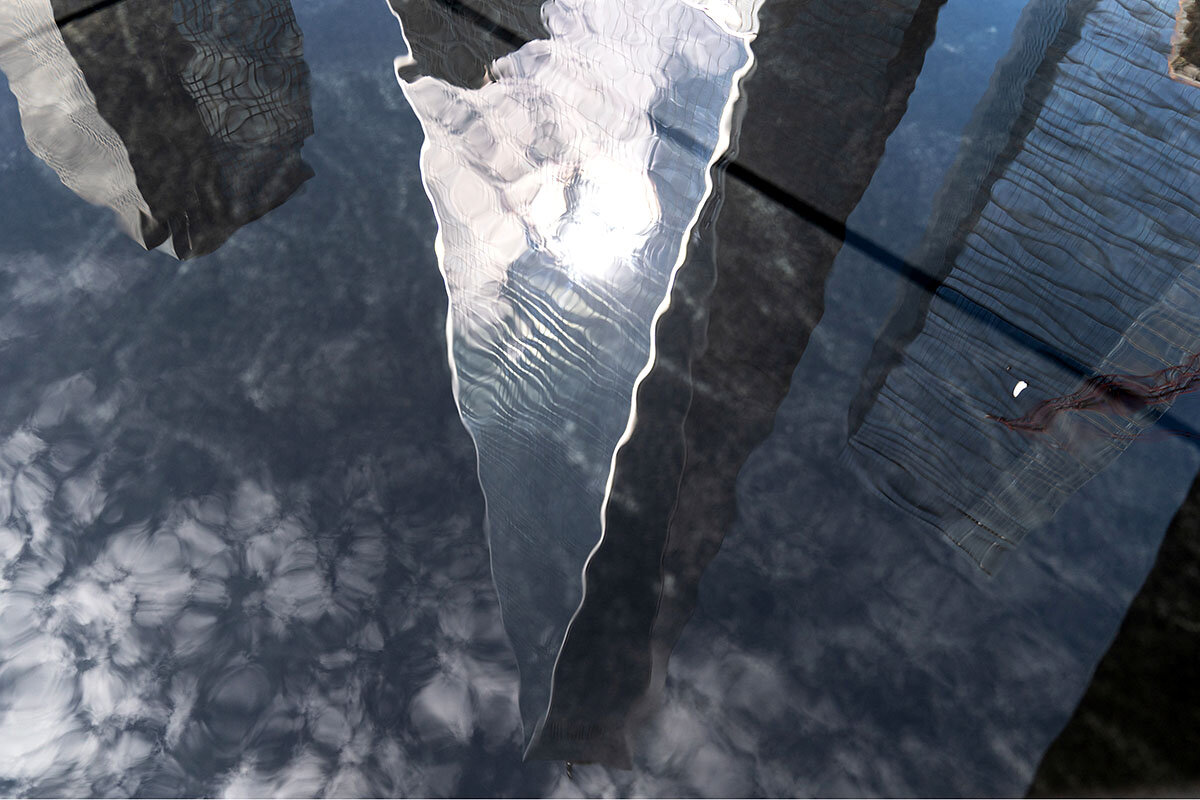
A look ahead
Thanks for joining us today for our commemorative issue on 9/11’s legacy. Tomorrow we’ll be back with a regular Daily. We’re working on a story that considers whether Big Tech should become more aggressive arbiters of truth.


